Choosing the Best Lenses for Wildlife Photography
PhotoWILD Gear’s Field-Tested Guide for Capturing the Wild Side of America
Imagine you’re tucked into a blind at dawn, camera poised, when a herd of bison suddenly charges across the prairie. With dust flying, hooves pounding, and your heart racing faster than your shutter speed. Or maybe you’re tracking a bald eagle as it dives with pinpoint accuracy, snatching a fish from a lake like it’s grabbing drive thru. These are the moments why we love wildlife photography! It’s such an adrenaline rush – and it’s why having the right lens is absolutely essential.
Because let’s be real: Wildlife doesn’t strike a pose or give second chances. Whether you’re trying to freeze the explosive leap of a whitetail deer or catch a sharp-eyed shot of a coyote at dusk, your lens is your closest ally in capturing the wild beauty of America’s backcountry and you want to be as ready as you can be.
Welcome to the PhotoWild Gear Best Wildlife Lens Guide
This guide on the best lenses for wildlife photography is not just a basic but comprehensive resource built on practical experience. It begins by exploring the camera bodies you might be using, from mirrorless and DSLR to crop sensors and Micro Four Thirds (yes, we’ll explain what those mean without putting you to sleep).
Next, we dive into the core aspects of selecting the ideal lens for photography, focusing on factors such as focal length, aperture, image stabilization and the specific scenarios, whether capturing songbirds in your backyard or observing elk in the Rockies. We will examine the differences between zoom and prime lenses, weigh portability against performance, and determine when carrying a large lens is justified.
Whether you are adventurer or an experienced wildlife photographer, this guide will assist you in making smart informed decisions about which lenses will be suitable for your needs.
Let’s get wild (in sharp focus).
Top Wildlife Lens Picks
We’ll explore various best lenses for wildlife photographers from renowned brands like Canon, Nikon, Sony, and OM System and explain how each one impacts the final image you capture. Each recommendation is specifically chosen for its ability to capture breathtaking wildlife imagery, ensuring you find the perfect fit for your camera and creative vision.
Before we get there though, we will look at focal lengths, aperture, prime versus zoom, and an overview of camera bodies. However, if you want to jump straight to the lenses, click the links below to take you right there.
Jump to: Canon | Nikon | Sony | OM System
At the end of this guide, you’ll have the knowledge and confidence to choose the best lens for capturing stunning wildlife photos that you’ll want to share with everyone.
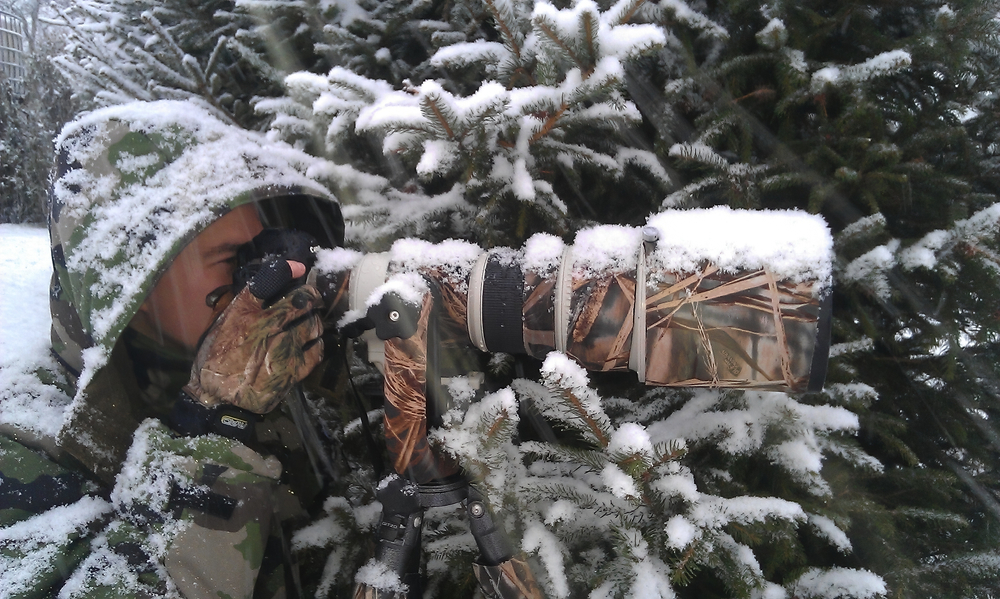
Importance of Focal Length in Wildlife Photography
Bringing Wildlife Closer—Without Getting Too Close
When it comes to wildlife photography, focal length is often considered the most critical element in choosing the right lens. Why? Because it directly influences how close your subject appears in the frame – without you needing to physically approach the animal, which could risk disturbing its behavior or even putting you in harm’s way.
Understanding focal length allows you to make informed decisions about the types of lenses that best suit your subject matter, shooting style, and field conditions. Whether you’re photographing a soaring bald eagle or a herd of elk grazing at dusk, the right focal length can help you tell a more powerful visual story.
What Is Focal Length, and Why Does It Matter?
Focal length, measured in millimeters (mm), determines two key aspects of your image:
- Subject magnification – how large or close your subject appears in the photo.
- Field of view – how much of the surrounding scene is included in the frame.
In wildlife photography, these two characteristics are especially important. A longer focal length allows you to photograph animals from a safe distance without sacrificing detail, while also helping to isolate the subject from its background.
Let’s break down how different focal lengths behave – and what types of shots they’re best suited for.
Super Telephoto Lenses (300mm and Above)
Perfect for Distant Wildlife and Intimate Close-Ups
Once you enter the 300mm+ territory, you’re working with super telephoto lenses – the go to choice for most wildlife photographers. These lenses are essential when photographing elusive or distant animals, such as birds in flight, wolves, or moose on the move across a valley
Examples: 400mm, 500mm, 600mm, 800mm lenses
- Allows for safe, ethical distancing from wildlife.
- Produces a narrow field of view, effectively isolating your subject.
- Creates a compressed perspective, where the background appears closer and more blurred which is ideal for drawing attention to your subject.
When it comes to photographing wildlife from a distance, super telephoto lenses those with focal lengths of 300mm and beyond are essential. These lenses allow you to capture tight shots of animals without disturbing them, maintaining both safety and authenticity in your images.
Importantly, super telephoto lenses come in two main types: prime and zoom.
- Prime lenses, such as a 600mm f/4, offer exceptional image quality, wider apertures, and superior sharpness. However, they come with a fixed focal length, meaning you’ll need to physically move to change your framing.
- In contrast, super telephoto zoom lenses – like a 100-400mm, 150-600mm, or 200-600mm – offer flexibility and convenience. They allow you to adjust your composition on the fly, which is especially helpful when wildlife is on the move or when shooting from a stationary position.
Choosing a prime or zoom super telephoto lens depends on your style, budget, and shooting conditions. Both can deliver stunning results, but each comes with its own set of trade-offs.
Use Case:
A 600mm lens can be a game-changer when photographing wildlife from a distance. In practical terms, it allows you to fill the frame with a perched hawk from over 50 feet away. It can capture intricate feather details and sharp focus, all without needing to move closer and risk disturbing the bird. Moreover, this longer focal length delivers excellent background separation, producing that creamy, professional-looking bokeh that makes your subject truly stand out.
Whether you choose a prime 600mm lens for its superior sharpness and low-light performance, or a zoom lens that reaches 600mm, like a 150–600mm or 200–600mm, you’ll have the flexibility to adapt to dynamic shooting scenarios in the field. Zooms allow you to reframe quickly without moving your feet, while primes offer unmatched optical clarity. Ultimately, both can deliver stunning results, it’s all about finding the right balance between precision, versatility, and your personal shooting style.
Medium Telephoto Lenses (70mm–300mm)
A Versatile Range for Closer Subjects and Habitat Shots
As you move down in focal length, medium telephoto lenses offer increased versatility. For instance, they’re great for photographing deer, bison, or foxes at moderate distances. Additionally, these lenses allow you to include more of the surrounding landscape in your shot. So, if you want context and subject in one frame, this range is a strong choice.
- Examples: 70-200mm, 100-400mm, 70-300mm
- Benefits:
- Strikes a balance between reach and compositional context.
- Easier to handhold compared to super-telephotos.
- Great for dynamic framing—zoom in tight, or pull back for environmental portraits.
- Use Case: At 200mm, you can photograph a bear fishing near a riverbank while still capturing the water, trees, and light that tell a fuller story.
Normal Lenses (35mm–70mm)
What the Eye Sees – And Sometimes More
While not a typical first choice for wildlife work, normal lenses can serve a role, particularly for photographers working in controlled environments like wildlife reserves or photographing domesticated animals. These lenses approximate the human eye’s field of view, making images feel grounded and familiar.
- Examples: 50mm prime, 35mm f/1.8, 40mm pancake lenses
- Benefits:
- Lightweight and discreet.
- Natural-looking perspective with minimal distortion.
- Can be creatively used for storytelling or wide-area wildlife setups.
- Use Case: Use a 50mm lens to photograph a grazing deer with a wide open field behind it for a peaceful, balanced composition.
Wide-Angle Lenses (Below 35mm)
Wide Views for Big Landscapes—and Small Wildlife
Though rarely the focal point of a wildlife photographer’s gear bag, wide-angle lenses have a unique place in the creative process. While they lack the magnification needed for close-up shots, they’re excellent for environmental storytelling, where the landscape plays just as big a role as the animal.
- Examples: 24mm, 16-35mm zoom, 14mm ultra-wide
- Benefits:
- Emphasizes the habitat and scale of the scene.
- Ideal for dramatic skies, sweeping plains, or forest compositions.
- Can be paired with remote triggers for capturing animals up close in wide context.
- Use Case: Imagine photographing a herd of bison on the open plains of Yellowstone at 24mm—capturing not only the animals but the grandeur of the setting sun behind them.
How to Choose the Right Focal Length for Your Wildlife Photography
When choosing your ideal focal length, consider the following factors:
- Subject type: Birds usually require longer focal lengths (500mm+), while larger mammals may be captured well at 200-400mm.
- Habitat access: If you’re photographing from blinds, vehicles, or hiking trails, longer focal lengths may be essential.
- Style preference: Do you prefer tight animal portraits or wider, storytelling compositions?
- Camera sensor size: Remember that crop sensor cameras provide extra reach (1.5x or 2x crop factor), effectively turning a 300mm lens into a 450mm or 600mm equivalent.
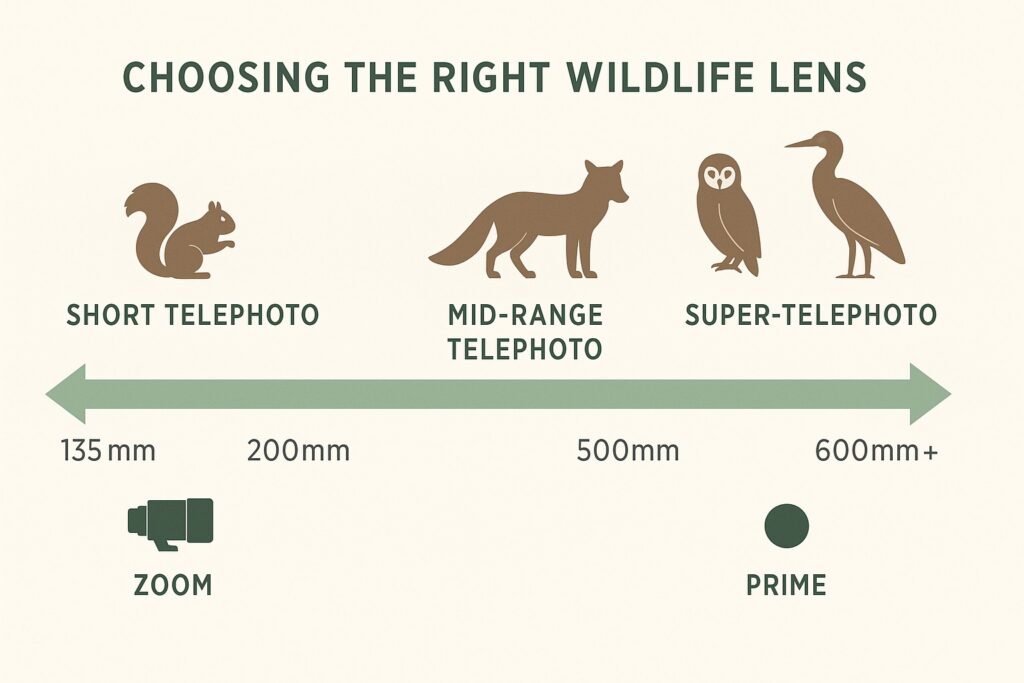
In Summary
Focal length is more than just a number. It’s a powerful part of your wildlife photography gear.
For instance, longer focal lengths are ideal for close-up shots of animals like a red fox at golden hour.
In contrast, wide-angle lenses capture expansive scenes like elk grazing under stormy skies in a dramatic landscape.
Clearly, understanding focal length helps you create stronger, more compelling wildlife images. No matter your experience, choosing the right focal length enhances your wildlife photography gear setup.
Ultimately, it allows you to make the most of every wild encounter and capture unforgettable moments in nature.
Know Your Reach: A Visual Focal Length Chart
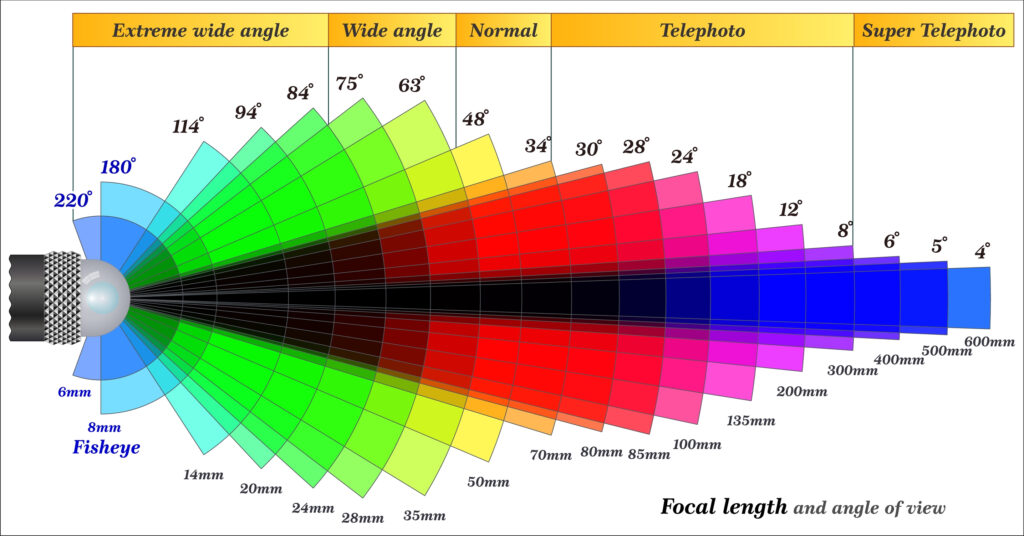
Minimizing Camera Shake – Techniques and Tools
Using a lens with a higher focal length can bring distant subjects closer, but it also amplifies any camera shake. Even minimal movement of the camera during exposure can result in a blurred image.
Increasing Shutter Speed
Following the “reciprocal rule,” it’s recommended to use a shutter speed that’s at least equivalent to the lens’s focal length (for example, 1/200th of a second for a 200mm lens) to minimize camera movement.
Image Stabilization (IS)
Many cameras and lenses are equipped with image stabilization technology. IS mitigates camera shake by adjusting the lens element to offset slight movements.
Using a Tripod or Support
Employing a tripod or another steady surface can completely remove camera shake, which is particularly beneficial in low-light conditions or when sharpness is paramount. We will cover some of the most ideal tripods for wildlife Photographers in the next blog.
Bracing Technique
For handheld shooting, stabilize yourself by gripping the camera with both hands and keeping your elbows close to your body for extra steadiness. Leaning against a wall or another sturdy object can also provide additional support.
Practice and Experience
The steadier your hand, the clearer your shots will be, and this steadiness improves with practice, so be sure to get out there as often as you can and practice, practice, practice.
Sensor Size
Sensor size does not directly impact a camera’s resistance to camera shake. The resistance to camera shake is primarily determined by the stabilization systems within the camera and the technique used by the photographer.
However, larger sensors often perform better in low-light conditions. They can produce higher-quality images, which may give the impression of being more resistant to camera shake due to the resulting sharper and more detailed images.
Subject Movement
When photographing moving subjects, such as birds, relying solely on a fast shutter speed to counteract camera shake may not be sufficient to freeze the motion. In such situations, it may be necessary to experiment with even faster shutter speeds.
Understanding the relationship between focal length and camera shake is crucial for capturing sharp wildlife images, especially when using long lenses. Techniques such as increasing the shutter speed or using a tripod can greatly enhance the quality of the results.
Prime vs. Zoom Lenses: Which is best for Wildlife Photography?
Before engaging in the prime versus zoom lens debate, consider what fuels your passion for photography. Are you thrilled by the prospect of capturing the grandeur of large wildlife such as bison or elk in the American wilderness, or does bird photography captivate you?
Outstanding lenses are designed to serve both interests if your enthusiasm extends to wildlife and bird photography. Identifying your primary interest in wildlife photography is key to selecting a lens that aligns with your style and budget.
When choosing the best lenses for wildlife photography, the lens choice is not just a tool, it’s a pivotal decision that can elevate your photos to breathtaking levels. Prime lenses, with their superior image quality, are suited for those who are patient and meticulous. On the other hand, zoom lenses offer versatility, ready to adapt to spontaneous situations. We will examine the advantages and disadvantages of each to empower you in finding the lens that best fits your style and goals.
Prime Lenses – A Purist’s Choice for Wildlife Photography:
Sharper Images
Prime lenses are fixed focal length lenses that offer superior image quality and are often faster than zoom lenses. They can also be smaller and more portable than zoom lenses.
Lighter & More Compact
Increased light intake: The wider apertures of prime lenses allow more light to reach the camera sensor, which is advantageous for photography in low-light conditions.
Shallower Depth of Field
The wider aperture also produces a shallower depth of field, ensuring that a smaller area of the image is in focus. This feature is perfect for subject isolation and achieving a pronounced background blur, known as bokeh.
Affordability
“Typically,” prime lenses are more affordable than their high-end zoom counterparts due to their simpler construction with fewer elements, which makes them cheaper to produce. It’s possible to find prime lenses of excellent quality at a reasonable price. Nonetheless, there are exceptions.
Certain specialized prime lenses, especially those with ultra-wide apertures (f/1.2 or wider) or exceptionally long focal lengths (600mm or more), can be quite costly, and will see once we delve into the different prime lens for wildlife photography.
Downside of a Prime Lens
Limited Framing Flexibility and Slower Reaction Time
Prime lenses lock you into a specific focal length. If you need to adjust framing quickly for wildlife on the move, you’ll need to physically move closer or further away, which might not always be possible.
To cover a wider range of focal lengths, wildlife photographers often need to carry several prime lenses. This can add weight and bulk to your gear bag, especially compared to a zoom lens.
Also, swapping lenses in the field takes time, potentially causing you to miss fleeting moments of wildlife behavior. This can be a disadvantage for fast-paced action shots, you don’t want to be changing a lens out in the middle of an incredible scene and blowing the moment.
Lower Low-Light Performance (Depending on Aperture)
While some prime lenses boast wider apertures (f/1.4 – f/2.8) ideal for low-light conditions, not all do. A slower prime lens might necessitate adjusting ISO or using flash in low-light situations, unlike a zoom lens with a broader maximum aperture.
When purchasing a lens, be sure to check its aperture to ensure it meets your needs. As you might expect, glass with apertures of (f/1.4 – f/2.8) is considerably more costly than glass starting at (f/5.6).
Zoom Lenses: The Essence of Adaptability for Wildlife Photography
Versatility
Zoom lenses provide the ability to modify focal length within a specific range, such as 100-400mm, enabling you to alter the framing of your subject without the need to change lenses. This is ideal for dynamic situations or when encountering unpredictable wildlife.
Convenience
A single zoom lens equips you for a multitude of wildlife photography situations, ranging from intimate portraits to expansive environmental scenes. This advantage removes the necessity of carrying and exchanging several prime lenses.
The Trade-offs of Zoom Lens
Image Quality
Zoom lenses often sacrifice some image quality compared to prime lenses of the same focal length. This can manifest as slight softness, particularly at the edges of the frame, or increased chromatic aberration (color fringing).
Slower Apertures
Zoom lenses usually feature smaller maximum apertures (f/4, f/5.6, etc.) than prime lenses, which can be restrictive in low-light conditions or when trying to create a substantial background blur.
Bulk and Weight
Zoom lenses are generally heavier and bulkier compared to prime lenses, which may not be ideal in situations where portability is a key concern.
Cost Considerations
While high-quality zoom lenses can be costly, particularly those with extensive focal lengths and broad zoom ranges, there are still budget-friendly options. To find a zoom lens within your budget, consider the following:
Opt for mid-range zoom lenses that provide a reasonable focal length range (for instance, 70-300mm) without compromising on image quality. These lenses offer a compromise between cost and performance, making them a good choice for novice and intermediate wildlife photographers.
Third-party Lenses
Third-party lenses often deliver exceptional performance at a more attractive price point compared to brand-name equivalents allowing you to stretch your budget further and invest in higher-quality gear overall. Manufacturers like Sigma, Tamron, and Rokinon offer high-quality options for wildlife photographers.
Stay tuned for our upcoming blog post where we delve deeper into the world of the best third-party wildlife lenses and explore their specific strengths and benefits. We’ll equip you with the knowledge to make informed decisions and find the perfect third-party lens to complement your camera system and shooting style!
Treasure Hunt for Wildlife Photography Gear
The pre-owned camera equipment market offers a goldmine for budget-minded wildlife photographers! Reputable online marketplaces like B&H Photo, KEH Camera, and even reputable sellers on Ebay offer a vast selection of used lenses in good condition at significant discounts. Also be sure to check out your local camera store.
While considering used lenses, remember a thorough inspection is key. Look for scratches, body wear, and confirm smooth autofocus operation. Descriptions matter! Read them carefully to ensure the lens meets your needs. By following these tips, you can find a fantastic used lens and elevate your wildlife photography!
Prime vs. Zoom: Choosing the Right Lens for Wildlife Photography
A Matter of Focus—Literally and Figuratively
When it comes to selecting the best lens for wildlife photography, the choice often boils down to two main types: prime lenses and zoom lenses. While both can deliver stunning results, each comes with its own strengths and trade-offs. Understanding the differences between them will help you make an informed decision that aligns with both your style and your goals in the field.
The Case for Prime Lenses
Prime lenses have a fixed focal length – such as 400mm or 600mm – which means they don’t zoom in or out. While this might seem like a limitation at first glance, primes are often favored for a few key reasons:
- Superior Image Quality: With fewer moving parts and a simpler internal design, prime lenses typically deliver sharper images with better contrast and minimal distortion.
- Wider Maximum Apertures: Many prime lenses feature wider apertures (such as f/2.8 or f/4), allowing for better performance in low-light conditions, faster shutter speeds, and beautiful background blur (bokeh).
- Weight and Build: Though longer primes can be hefty, they are often lighter and more compact than comparable zooms of the same focal length.
- Ideal for Predictable Scenarios: If you’re photographing animals with relatively consistent behavior—like birds at a feeder or elk at a known watering hole – prime lenses offer a powerful, dedicated option.
However, their fixed focal length can be limiting. If your subject moves closer or farther away quickly, you’ll need to reposition yourself, which isn’t always possible in the wild.
Zoom Lenses: The Flexible Friend
Zoom lenses, on the other hand, offer a range of focal lengths in one package – like a 100–500mm or 200–800mm lens – making them a versatile choice for photographers who face changing conditions and unpredictable subjects.
- Adaptability in the Field: With a zoom lens, you can easily adjust your framing without needing to move your feet. This is invaluable when photographing animals on the move or in locations where mobility is limited.
- Convenience and Safety: Sometimes, getting closer isn’t an option—for your safety or the animal’s comfort. A zoom allows you to capture intimate shots from a respectful (and safe) distance.
- Cost Efficiency: Rather than buying several prime lenses, one high-quality zoom can cover a wide range of scenarios, making it a practical investment for many wildlife photographers.
That said, zoom lenses may sacrifice a bit of sharpness compared to their prime counterparts, particularly at their longest focal lengths. They also often have narrower maximum apertures (like f/6.3 or f/7.1), which can be a challenge in low-light situations.
Which Should You Choose?
Ultimately, the right choice depends on a few key factors:
- Your Budget
- Shooting Style
- Primary Subjects
- Environmental Conditions
If your style leans toward carefully planned outings with predictable wildlife behavior, and you value image clarity above all else, a prime lens could be your best ally. On the other hand, if you enjoy the thrill of chasing the unexpected or often shoot in diverse environments, a zoom lens offers the flexibility needed to adapt quickly.
Visual Comparison Chart: Zoom vs. Prime Lenses
| Feature | Zoom Lens | Prime Lens |
|---|---|---|
| Focal Length | Variable (e.g., 100–500mm) | Fixed (e.g., 600mm) |
| Flexibility | High – great for dynamic scenes | Low – must “zoom with your feet” |
| Image Quality | Very good (especially pro models) | Excellent – optimized sharpness |
| Aperture | Typically f/4.5–7.1 | Often f/2.8–f/4 – better in low light |
| Weight | Often lighter in mid-range models | Heavier in super-telephoto class |
| Cost | More affordable across ranges | More expensive (especially f/2.8/f/4) |
| Best For | Versatile shooting, moving subjects | Maximum detail, low-light scenes |
Final Thoughts
Choosing between prime and zoom lenses isn’t just about specs – it’s about how you shoot, where you shoot, and what inspires you behind the lens. Whether you prefer the precise punch of a prime or the all-in-one adaptability of a zoom, both can help you create unforgettable images of the wild. The key is to match the gear with your vision – and then get out there and let nature surprise you.
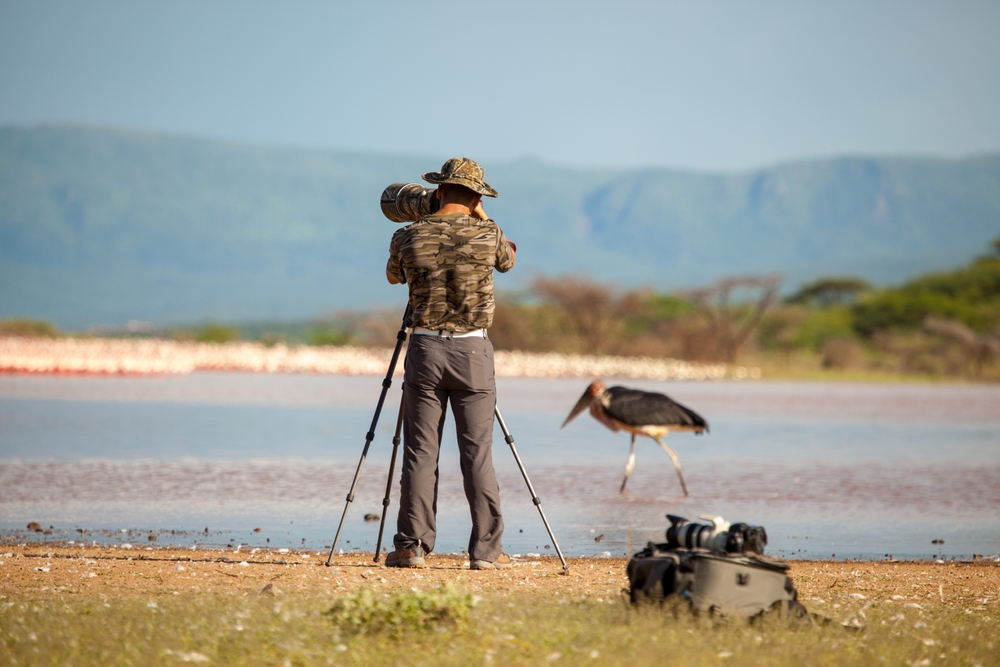
Double Duty: The Reason Some Wildlife Photographers Carry Two Cameras
Professional wildlife photographers often carry two cameras, each equipped with a different lens, to prepare for various shooting scenarios without quickly switching lenses. Typically, one camera is fitted with a prime lens known for its superior image quality, while the other sports a zoom lens, perfect for fast action shots or capturing distant wildlife.
The optimal choice depends on individual needs and style. Factors such as budget, specific wildlife subjects of interest, and the environments where most photography takes place must be considered.
By considering these elements, photographers can determine if a combination of prime and zoom lenses provides the most versatility for wildlife photography. This lens setup allows them to capture a wide range of shots, from detailed close-ups to action-packed shots of distant wildlife, thereby enhancing the diversity of their portfolio.
Why Aperture Matters in Wildlife Photography
Conquering Low Light (f/2.8 vs f/5.6)
When it comes to wildlife photography, capturing the perfect shot can be challenging. This is especially true when shooting at dawn, dusk, or in dense forests where light is scarce. In these situations, having a lens that can handle low-light conditions is essential. To achieve this, you need a wider aperture, which is indicated by a lower f-stop number.
A wider aperture allows more light to reach the camera sensor, resulting in sharper photos. For example, an f/2.8 lens gathers significantly more light compared to an f/5.6 lens (roughly one stop of light). This increased light intake lets you use a faster shutter speed, which is crucial for freezing action and capturing sharp photos. With a faster shutter speed, you can freeze action and capture sharp photos even in low-light conditions.
Beautiful Blur: Bokeh (f/4 vs f/8)
Using a wider aperture when taking photographs can result in a more attractive background blur, also known as bokeh. This blur helps to separate the subject from its surroundings, making it stand out more.
For example, in a wildlife portrait, a wider aperture can create a soft, dreamy blur in the background, making the animal the focal point of the image. By strategically selecting a wider aperture, you can transform a distracting background into an artistic element that enhances your wildlife portraits.
Depth of Field and Sharpness
On the other hand, a smaller aperture, like f/8, provides a greater depth of field, which brings more of the scene into focus. While this can be useful for landscape-oriented wildlife shots but may detract from the subject in close-up portraits where a blurred background is desired to highlight the animal.
The diagram below illustrates the effects of stopping down and opening up the aperture. Take note of the significant difference in what is in focus between F22 and F1.4.
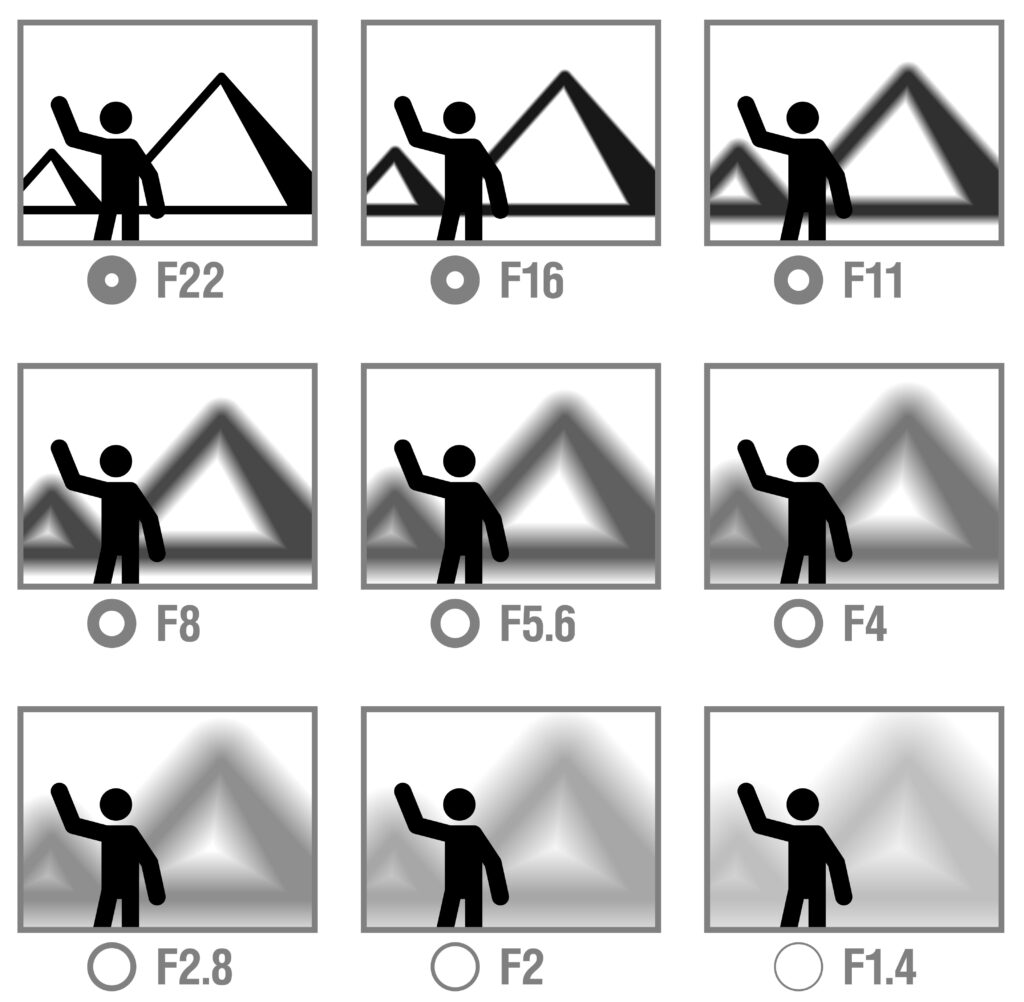
Have you come across the terms “stopping down” and “opening up”? They describe the adjustment of the aperture size, which dictates the amount of light reaching the camera’s sensor.
Opening Up
Involves using a wider aperture, denoted by a smaller f-stop number (e.g., f/1.8, f/2.8), similar to opening a door wider to allow more light to come in.
- More light: Beneficial in dim settings or for quicker shutter speeds.
- Shallower depth of field: A limited area around the focus point remains sharp, causing the foreground and background to blur, ideal for highlighting the subject.
Stopping Down
This involves using a narrower aperture, signified by a larger f-stop number (e.g., f/8, f/16), comparable to partially closing a door to reduce light entry.
Less light: Necessitates compensatory measures like a slower shutter speed or a higher ISO.
Deeper depth of field: A greater part of the image stays in focus, from the foreground to the background, perfect for landscape or group photos to keep everything crisp.
Opening Up = More Light, Less Sharpness (Shallower Depth of Field)
Stopping Down = Less Light, More Sharpness (Deeper Depth of Field)
Demystifying Camera Bodies: Finding the Perfect Match for Your Wildlife Lens
The vast world of wildlife photography isn’t just about the lenses you use – it’s also about the camera body that forms the foundation of your entire setup. Whether you’re a brand loyalist or just starting to explore, choosing the right camera system is crucial. This guide unravels the pros and cons of the four main contenders: mirrorless, DSLR, Micro Four Thirds (MFT) and crop sensor cameras. This will help you find the perfect match for your wildlife photography aspirations.
If you want to skip right pass the camera section to the part about lenses, zoom closer to the bottom of the page to: Capturing the Wild: Best Lenses for Canon, Nikon, Sony, and OM System
Mirrorless Systems
Advantages of Mirrorless Systems for Wildlife Photography
Lightweight and Compact
Mirrorless cameras are generally smaller and lighter than DSLRs, making them ideal for photographers who value portability, especially on long hikes or treks.
Silent Operation
Unlike DSLRs, mirrorless cameras use electronic shutters, making them nearly silent which is perfect for wildlife photography. Because there’s no loud shutter click, you can shoot without startling animals.
Additionally, in quiet groups of mirrorless shooters, a DSLR’s click really stands out, sometimes humorously so.
For instance, the pronounced shutter sound of a DSLR might frighten a bird, prompting it to fly off before the ideal photo is taken. On the other hand, the quietness of a mirrorless camera allows for unobtrusive photography, capturing the bird undisturbed in its natural habitat.
Advanced Electronic Viewfinders (EVFs)
Modern mirrorless cameras boast high-resolution EVFs that provide a clear, detailed view of the scene in real time.
As a result, you can compose your shot and preview exposure, white balance, and depth of field before taking the photo.
Unlike traditional optical viewfinders, EVFs show exactly how your image will look, reducing the need for guesswork.
Additionally, this helps save time in the field, especially when lighting conditions change quickly.
Video Capabilities
Many mirrorless cameras offer 4K video recording, and some even go beyond that to 6K or 8K resolutions. This allows for capturing high-quality footage with a lot of detail, which is ideal for professional videography or future-proofing your work.
Fast Continuous Shooting
When it comes to capturing wildlife in action, mirrorless cameras are an excellent choice due to their superior continuous shooting speeds. Unlike DSLRs, which have flipping mirrors that can cause distractions and scare off animals, mirrorless cameras are much quieter. This electronic approach enables them to capture a rapid sequence of images without causing any disturbance.
With speeds often exceeding 10 frames per second (fps), mirrorless cameras can capture the slightest movement of wildlife. In some cases, some models can even achieve a staggering 20 fps or higher, making them ideal for capturing the fast-paced movement of wild animals.
Disadvantages of Mirrorless Cameras for Wildlife Photography
Shorter Battery Life
Although battery life in mirrorless cameras is improving, it still falls short of most DSLRs due to constant power demands.
Because EVFs and live view use more energy, it’s wise to carry extra batteries for extended wildlife shoots.
Fortunately, many newer models support USB-C charging, offering added convenience when you’re out in the field.
As technology advances, battery performance continues to improve, helping reduce one of mirrorless cameras’ key disadvantages
Potential Autofocus Limitations
While autofocus technology in mirrorless cameras has improved significantly, some models might struggle with fast-moving subjects compared to certain DSLRs.
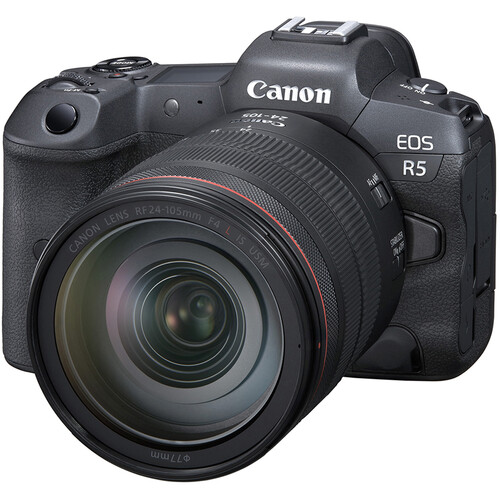
DSLR Systems
Advantages of DSLR Systems for Wildlife Photography
While mirrorless cameras are gaining traction, DSLRs still offer distinct advantages for wildlife photographers:
Unbeatable Viewfinders
Boasting large, DSLR cameras are equipped with high-quality optical viewfinders (OVFs) that provide a clear and natural view of the scene, even in bright sunlight. This is crucial for wildlife photography, where quick composition and tracking of fast-moving subjects are essential. Some photographers simply prefer the OVF experience for its familiarity and lack of lag.
Superior Battery Life
Reigning supreme in terms of battery life, DSLRs usually only require a single charge, often allowing you to capture hundreds of shots. This is ideal for long wildlife photography expeditions where access to power might be limited. The extended battery life ensures you never miss that perfect wildlife moment due to a dead camera battery.
Vast Lens Selection
The DSLR system have been around for decades, resulting in a wider and more mature lens ecosystem. You’ll find a vast selection of lenses specifically designed for wildlife photography, from affordable options to high-end professional lenses. This extensive choice allows you to tailor your lens kit to perfectly suit your wildlife photography needs and budget.
Proven Workhorse Reliability
DSLRs are known for their rugged construction and dependable performance. These cameras are built to withstand the rigors of outdoor adventures, making them a reliable companion for wildlife photography trips, where harsh weather conditions or dusty environments might be a concern.
Disadvantages
While DSLRs offer undeniable advantages, there are some drawbacks to consider:
Bulkier and Heavier
Compared to mirrorless cameras, DSLRs with telephoto lenses can be significantly bulkier and heavier. This can be a major disadvantage for photographers who prioritize portability, especially on long treks or wildlife expeditions where carrying gear for extended periods becomes tiring. Those extra pounds can get heavy after a while!
Noisier Operation
Having a mirror mechanism inside a DSLR creates a noticeable shutter click sound. This can be a deterrent for wildlife photography, where remaining discreet and avoiding spooking animals is crucial. While some DSLRs offer silent shooting modes, these often come with limitations like slower shutter speeds or limited autofocus functionality.
Slower Autofocus (Potentially)
While generally improving, autofocus systems in some DSLRs might not be quite as fast and accurate as their mirrorless counterparts, especially in low-light situations. This can be a disadvantage for capturing fast-moving wildlife or unpredictable behaviors.
Optical Viewfinder (OVF) versus Electronic Viewfinder (EVF)
Unlike mirrorless cameras, DSLRs lack an electronic viewfinder (EVF). An EVF allows you to preview the image with exposure adjustments and focus peaking before capturing the shot, which some photographers find beneficial. Unlike an EVF, DSLRs use an optical viewfinder (OVF). An OVF lets you see directly through the lens using a system of mirrors.
Hybrid Approach – Live View
Some DSLRs bridge the gap between OVF and EVF with a feature called Live View. It allows you to see the image from the camera’s sensor on the rear LCD screen, similar to an EVF. This offers benefits like:
Real-time exposure feedback: See how adjustments to aperture, shutter speed, and ISO affect the image before taking the shot.
Focus peaking: Highlights sharp areas for precise manual focusing, especially helpful in low light.
However, Live View in DSLRs typically doesn’t have a dedicated high-resolution viewfinder like an EVF. Also, composing through the rear LCD screen can be awkward in bright conditions or for extended shooting sessions.
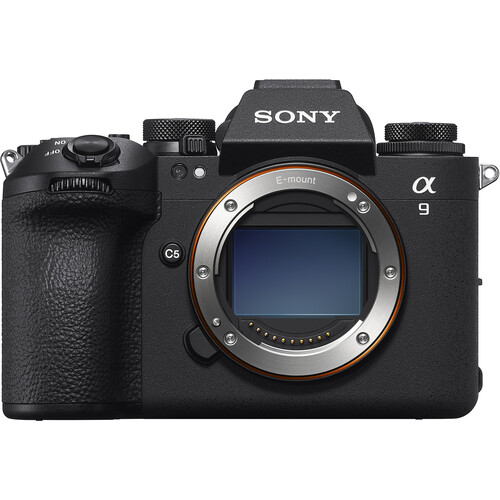
Crop Sensor Cameras
Crop sensor cameras offer a compelling option for beginners and intermediatory photographers. Here’s a quick breakdown of their pros and cons:
Advantages
Closer to the action
Crop sensor cameras have a smaller sensor that creates a longer effective focal length. This means your lens “zooms in” more compared to a full-frame camera, getting you close to wildlife without needing a super-telephoto lens.
Beginner and Budget-friendly choice
Crop sensor cameras and compatible lenses are generally more affordable than their full-frame counterparts. This makes them a fantastic entry point for aspiring wildlife photographers to learn the ropes without a hefty investment.
Disadvantages
Low-light limitations
The smaller sensor size captures less light, which can lead to more image noise (grain) in low-light situations like dawn, dusk, or dense forests.
Reduced dynamic range
Crop sensor cameras may struggle to capture the full range of tones (highlights and shadows) in scenes with high contrast, limiting creative flexibility in editing.
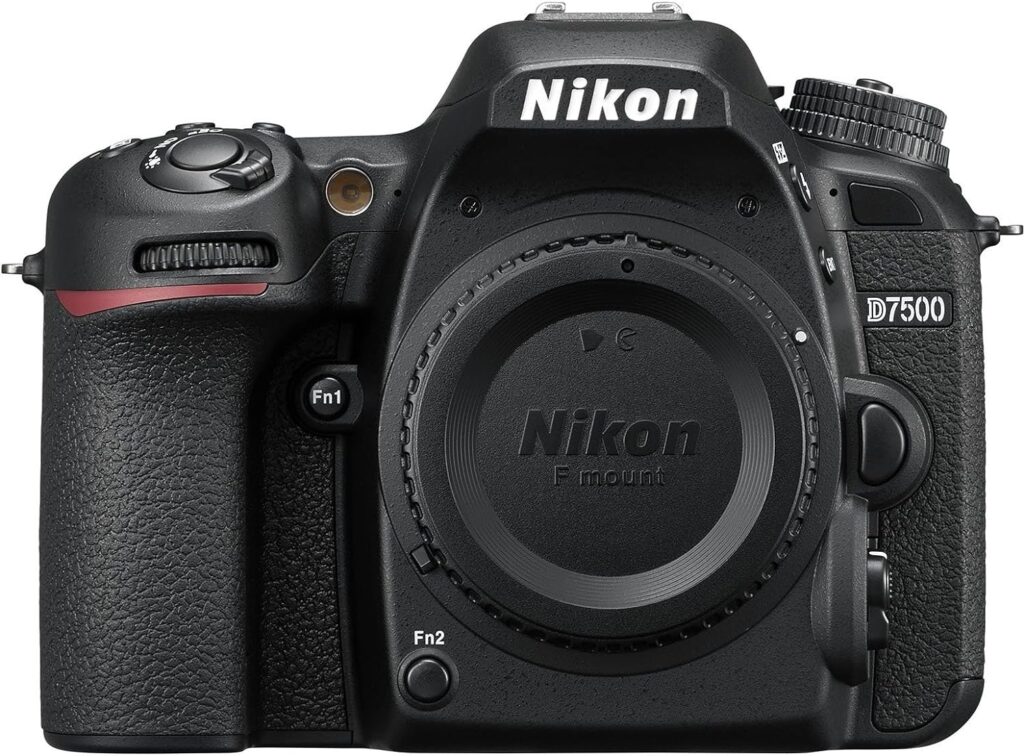
Micro Four Thirds (MFT)
Micro Four Thirds (MFT) cameras are a niche crop sensor system designed specifically for mirrorless cameras. They share many advantages with other crop sensor cameras, including:
Budget-friendly
MFT cameras and lenses are typically more affordable than their full-frame counterparts, making them a good option for cost-conscious wildlife photographers.
Compact and Portable
Their smaller sensor size translates to a lighter, more compact camera body perfect for carrying on treks or wildlife adventures.
Effective Focal Length Boost
Similar to other crop sensor cameras, MFT cameras offer an increased effective focal length when using the same lens as a full-frame camera. This allows you to get closer to the wildlife without needing an extra-long telephoto lens.However, there’s a trade-off for this compactness.
Low-Light Performance
MFT sensors are even smaller than those found in most APS-C crop sensor cameras. This can result in more noticeable image noise (grain) in low-light environments, common for wildlife photography at dawn, dusk, or in dense forests.
Limited Dynamic Range
MFT cameras might struggle to capture the full range of tones (highlights and shadows) in high-contrast scenes, reducing creative flexibility in post-processing.
Is MFT right for you?
If affordability, portability, and the effective focal length boost are your priorities, and you’re comfortable managing noise in low-light situations, then MFT cameras could be a compelling choice for wildlife photography.
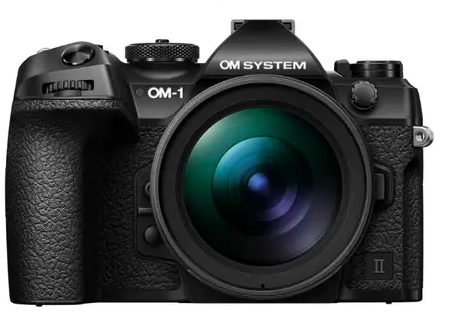
Sensor Showdown: Micro Four Thirds vs. Crop vs. Full Frame
The image below unveils the key difference between popular camera sensor sizes: micro four-thirds, APS-C (crop sensor), and full frame. The sensor size significantly impacts two key aspects of your image:
Field of View: Framing Your Shot with Precision
When composing a wildlife image, it’s essential to consider how much of the scene you want to include in your frame. This is where field of view comes into play, a concept directly influenced by your camera’s sensor size.
To begin with, full-frame sensors offer a wider field of view, closely resembling what the human eye naturally sees. This makes them ideal for capturing expansive environments, such as a herd of elk stretching across an open valley or a bear wandering through a wide riverbed.
In contrast, smaller sensors—such as APS-C (crop sensors) or Micro Four Thirds—provide a narrower field of view when using the same lens. As a result, your subject appears more “zoomed in,” which can be beneficial when photographing distant wildlife. However, this also means you may need to step back or switch to a wider focal length lens to include more of the surrounding habitat in your frame.
Therefore, as you plan your shot, it’s important to understand how your camera’s sensor size affects the composition and perspective of your image. Whether you’re aiming for tight portraits or environmental storytelling, knowing your field of view will help you make better lens choices and create more intentional wildlife photographs.
Low-Light Performance
Larger sensors have more surface area to capture light. This translates to better low-light performance with less image noise (grain) in your photos. Full-frame cameras generally excel in low-light situations compared to crop sensor and micro-four-thirds cameras.
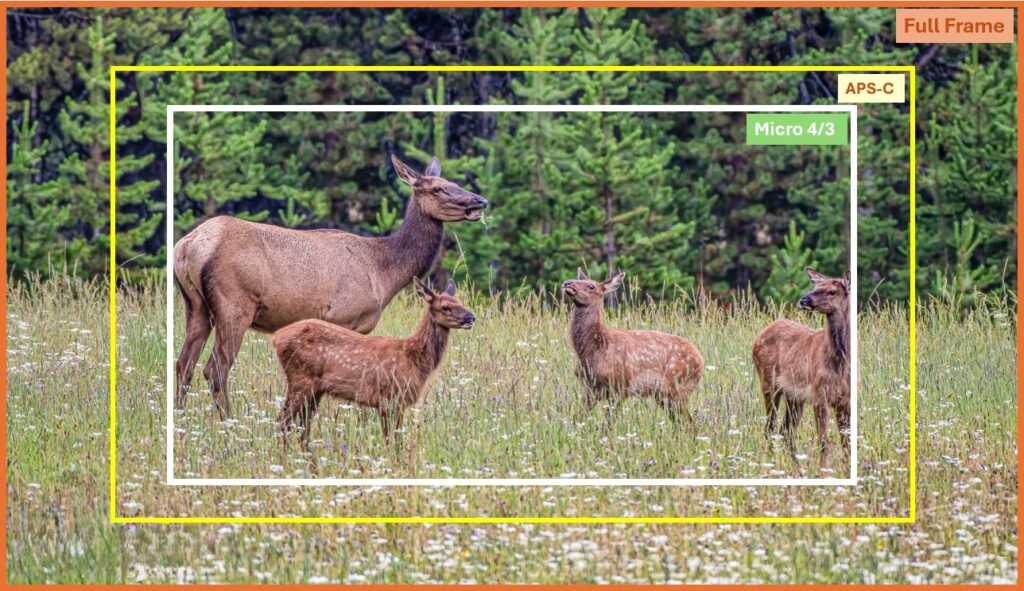
Capturing the Wild: Best Lenses for Canon, Nikon, Sony, and OM System
The natural world is full of captivating wildlife, from the flight of eagles to the playful antics of otters. As a wildlife photographer, capturing these moments requires the right tools. The lens you choose plays a crucial role in determining the success of your wildlife photography endeavors.
Now we’ve looked at some of the factors that need to be considered before purchasing a lens, this guide delves into the recommended lenses for Canon, Nikon, Sony, and OM System camera systems, specifically catering to the unique demands of wildlife photography.
We’ll explore factors like focal length, aperture, image stabilization, and compatibility to help you find the perfect lens to match your camera system and shooting style. Whether you’re a seasoned wildlife photographer or just starting your journey, this guide will equip you with the knowledge to capture stunning wildlife images that tell a story.
Top Wildlife Lenses – Zoom and Prime
When it comes to capturing the perfect wildlife shot, choosing the right lens is just as important as timing and technique. To help guide your decision, we’ll explore both zoom and prime lenses – highlighting their unique strengths and limitations so you can select the lens that best aligns with your wildlife photography style.
Understanding the Lens Landscape
To begin, we’ll provide a detailed analysis of the top-performing wildlife lenses across leading brands such as Canon, Nikon, Sony, and OM System. These recommendations are not only based on technical specs but also on our real-world experiences using them in the field. Whether it’s tracking elk at dawn or photographing egrets in flight, we’ve tested what works so you don’t have to guess.
Zoom vs. Prime: Which One is Right for You?
Next, we’ll break down the key differences between zoom and prime lenses. Zoom lenses offer flexibility, allowing you to adjust focal lengths on the fly – an ideal option when your subject is on the move or unpredictable. In contrast, prime lenses provide unmatched sharpness and low-light performance, perfect for more controlled shooting situations.
Key Factors to Consider
Furthermore, we’ll dive into essential criteria such as:
- Sharpness – How well does the lens resolve fine detail?
- Focal Length – Does it allow you to fill the frame from a safe and ethical distance?
- Image Stabilization – How effectively does it reduce camera shake in handheld scenarios?
By examining these factors, you’ll gain a deeper understanding of how each lens performs in a wildlife photography setting.
For Every Photographer – From Beginner to Pro
Whether you’re just getting started or you’ve logged years in the field, this guide is designed to meet you where you are. Beginners will appreciate the clear explanations and practical tips, while experienced photographers can dig into the nuanced comparisons and professional insights.
Let’s Get You Geared Up
So, if you’re ready to unlock the secrets of the best wildlife lenses, let’s dive in. This guide will not only sharpen your technical know-how but also equip you with the confidence to make the right gear choices for your next photo adventure in the wild.
Recommended Canon Lenses for Wildlife Photography
Canon boasts a robust selection of lenses for wildlife photography, catering to both mirrorless (RF) and DSLR (EF) camera systems. They are actively developing and releasing new RF lenses for its EOS R mirrorless system catering to beginners, professionals, and various photography needs.
While Canon still produces EF lenses for its DSLR cameras the development of new EF lenses has slowed down compared to the RF lens development. This reflects the overall industry trend towards mirrorless cameras.
Overall, the mirrorless market is growing, and Canon is strategically prioritizing lens development for its EOS R mirrorless system.
With that in mind, these are the top wildlife lenses we are covering in this blog, with most of the lenses being RF (mirrorless):
Here are some of our top Canon Lens picks
Mirrorless:
- Canon RF 800mm f/5.6 L IS USM Lens
- Canon RF 600mm f/4L IS USM Lens
- Canon RF 100-500mm f/4.5-7.1L IS USM Lens
- Canon RF 200-800mm f/6.3-9 IS USM Lens
DSLR:
- Canon EF 100-400mm f/4.5-5.6L IS II USM Lens
- Canon EF 200-400mm f/4L IS USM Extender 1.4x:
- Canon EF 600mm f/4L IS USM Lens:
Canon RF Lenses (Mirrorless)
1) Canon RF 800mm f/5.6 L IS USM Lens
As a wildlife photographer, we are always on the lookout for gear that can help us get closer to the animals we want to capture. The Canon RF 800mm f/5.6 L IS USM lens is an excellent choice for wildlife photography because of its capabilities.
With its 800mm focal length, this lens is perfect for taking portraits of even the most skittish animals, capturing every detail of their fur or feathers. Moreover, the f/5.6 maximum aperture is great for low-light situations and creates a beautiful background blur, isolating your subject from its surroundings.
Another advantage of this lens is Canon’s renowned image stabilization which ensures that your images are sharp and clear even at slower shutter speeds. This is perfect for situations where causing a disturbance is not an option. All these features make the RF 800mm f/5.6 L IS USM an exceptional lens for wildlife and birding photography. It brings you closer to the action, allowing you to capture stunning wildlife imagery.
Relatively lightweight and compact, this 800mm f/5.6 lens weighs 6.9 lb and measures 17″-long, making it realistic to use atop a monopod or even handheld for short periods of time.
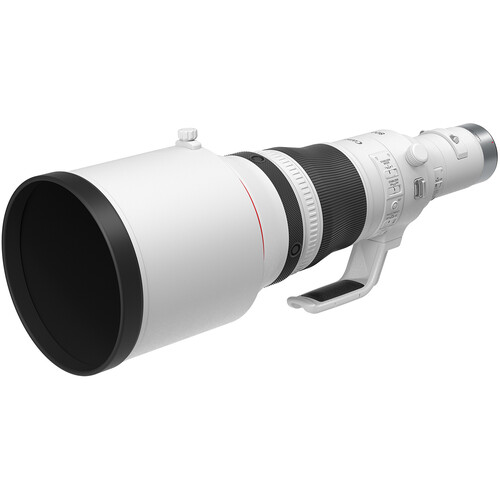
Technical Specifications:
- Mount: Canon RF Lens/Full-Frame Format
- Focal Length: 800mm
- Aperture Range: f/5.6 to f/64
- Weighs: 6.9 lb
- Lens Construction: 14 elements in 11 groups (likely, but not officially confirmed by Canon)
- Autofocus: Ring-Type USM Motor
- Image Stabilization: Built-in Optical Image Stabilizer (IS) with up to 4.5 stops of shake correction (CIPA standard)
- Minimum Focus Distance: Approximately 2.6 meters (8.53 ft)
- Maximum Magnification: 0.34x
- Filter Diameter: 95mm
- Weather Sealing: Yes, Fluorine Coating
- Dimensions (Diameter x Length): 168.1 x 463.8 mm (6.62 x 18.26 in)
- Weight: 2,690 grams (5.93 lbs)
- Rotating Tripod Collar
- Focus Range Limiter, Two Focus Presets
- Customizable Electronic Focus Ring
- Fluorite, Super UD, and UD Elements
Canon RF 800mm f/5.6 L IS USM Lens
Key Features
- Ultra-Telephoto Reach (800mm): Bring distant wildlife incredibly close, perfect for capturing wildlife across the vast landscapes of the USA in stunning detail.
- Exceptional Image Quality: Specialized optics minimize color fringing for crisp, high-resolution images.
- Balance of Light and Blur (f/5.6 Aperture): Works well in moderate low light and allows for a pleasing background blur to isolate your subject.
- Steady Shots (Image Stabilization): Up to 4.5 stops of image stabilization for sharp handheld wildlife shots at slower shutter speeds.
- Silent, Swift Focus (USM Motor): Capture fleeting moments of wildlife behavior with smooth, quiet, and high-speed autofocus.
- Built to Withstand the Wild (Weather Sealing): Protects the lens from dust, moisture, and occasional bumps encountered in various environments.
- Relatively Portable Powerhouse: Lighter than some super-telephoto lenses, making it manageable for wildlife photography adventures.
- Extendable Reach (Optional Extenders): Increase focal length and magnification for even more reach (with trade-offs on aperture).
Weighing the Pros and Cons
Pros:
- Exceptional image quality for professional wildlife photography.
- Impressive reach to capture distant wildlife in detail.
- Good balance between low-light capability and background blur.
- Effective image stabilization for sharp handheld shots.
- Fast and accurate autofocus for capturing fleeting moments.
- Durable build for demanding outdoor conditions.
- Relatively lighter weight at 6.9 lbs. than some comparable lenses.
Cons:
- Steep price tag – a significant investment
- Size and weight – a substantial lens, and a tripod is recommended.
- Limited versatility – a prime lens with no zoom functionality
- Low-light limitations – might require higher ISO in very low light.
- Extender trade-off – reduces the aperture and potentially autofocus speed.
- Focus peaking – some users might find it less precise in low light.
Summary
The Canon RF 800mm f/5.6 L IS USM is a high-end lens designed for wildlife photography. It stands out for its exceptional image quality, impressive zoom capabilities, and sturdy construction. However, it’s important to keep in mind the lens’s price, size, and limitations before making a purchase.
We recommend visiting your preferred camera store or renting this lens first to make sure it meets your specific needs and stays within your budget. That said, if you’re a passionate wildlife photographer aiming to capture extraordinary moments across the diverse landscapes of the USA, this lens could quickly become an indispensable part of your gear. In fact, its performance and reach may elevate your photography to new levels, especially when shooting elusive or distant subjects.
2) Canon RF 600mm f/4L IS USM Lens
The Canon RF 600mm f/4L IS USM Lens is a top-of-the-line lens that is an absolute game-changer for wildlife photographers. With its impressive 600mm focal length, it allows for unparalleled reach and image quality, making it possible to capture stunning close-ups of distant wildlife without disturbing their natural habitat.
Furthermore, the lens boasts exceptional optical performance, with advanced coatings that reduce flare and ghosting while ensuring that colors are rendered accurately. In addition, the lens features a fast and accurate autofocus system that ensures sharp and perfectly focused images, even when photographing fast-moving wildlife.
Another key feature of the Canon RF 600mm f/4L IS USM Lens is its image stabilization technology, which compensates for camera shake and allows for sharp handheld shots even in low-light conditions. This feature, combined with the lens’s large maximum aperture of f/4, makes it possible to capture stunning shots in challenging lighting situations, such as early mornings or late afternoons.
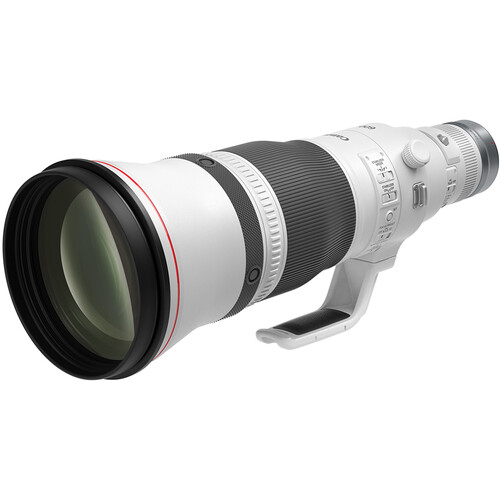
Technical Specifications:
- Type: RF-Mount Lens/Full-Frame Format/Fixed
- Mount: Canon RF
- Focal Length: 600mm
- Aperture Range: f/4 to f/32
- Image Stabilization: Yes (Up to 5.5 stops)
- Minimum Focusing Distance: 13.78 ft. (4.2 m)
- Filter Diameter: 54mm
- Weather-Sealing: Yes – Fluorine Coating
- Weight: 6.85 lbs. / 3.11 kg
- Super UD and Fluorite Elements
- Super Spectra and Air Sphere Coatings
- Customizable Electronic Focusing Ring
- Optical Image Stabilizer
- Two Focus Presets
- Circular 9-Blade Diaphragm
- Rotatable Tripod Collar
Canon RF 600mm f/4 L IS USM Lens
Key Features
- Low-Light Excellence: Its wide f/4 maximum aperture ensures sharp, detailed images in challenging lighting conditions such as dawn, dusk, or dense forests.
- Steady Shots: The built-in image stabilization reduces camera shake by up to 5.5 stops, enabling you to use slower shutter speeds for creative shots without compromising clarity.
- Fast Autofocus: The lens boasts a fast and accurate autofocus system that tracks wildlife movements effortlessly, ensuring you never miss a moment of action.
- Weather-Resistant: With weather-sealed construction, this lens is built to withstand harsh outdoor conditions, allowing you to shoot in rain, dust, or snow.
Weighing the Pros and Cons
Pros
- Exceptional Image Quality: This lens is well-known for its exceptional sharpness and clarity, making it perfect for professional-grade wildlife and sports photography.
- Superior Low-Light Performance: With its fast f/4 maximum aperture, this lens is excellent at capturing wildlife and action in low light conditions. Additionally, it allows for beautiful background blur, making it perfect for artistic compositions.
- Unmatched Image Stabilization: Canon’s top-of-the-line image stabilization system effectively combats camera shake, enabling sharp images even at slower shutter speeds, which is crucial for wildlife photography.
- Built for the Elements: The weather-sealed construction of this lens protects it from dust and moisture, ensuring confident shooting in challenging outdoor environments.
- Fast and Accurate Autofocus: The advanced autofocus system with dual Nano USM motors provides rapid and precise subject tracking, which is critical for capturing fleeting wildlife moments.
- Extender Compatibility: This lens can be paired with Canon’s RF 1.4x and 2x teleconverters for even greater effective focal length, bringing distant subjects even closer.
Cons
- Steep Price Tag: As a professional-grade lens, this option comes with a significant cost. It’s a significant investment that may not be feasible for casual photographers.
- Size and Weight: Keep in mind that this lens is bulky and heavy, and it can be cumbersome for travel or situations requiring long periods of handheld shooting. Consider a tripod or monopod for support.
- Limited Macro Capabilities: While capable of close-up focusing, it’s not a dedicated macro lens. If capturing extreme close-ups of insects or small creatures is a priority, you might need a dedicated macro lens alongside this telephoto option.
Summary
The Canon RF 600mm f/4L IS USM Lens is a perfect fit for wildlife photographers who are looking for unmatched performance and versatility. Although it comes with a higher price tag, its exceptional performance, and build quality justify the investment for serious photographers.
It is a valuable investment that will deliver stunning results for years to come. This lens is perfect for both amateur and professional photographers, and it will exceed your expectations by helping you capture breathtaking images of wildlife in their natural habitat.
3) Canon RF 100-500mm f/4.5-7.1L IS USM Lens
The Canon RF 100-500mm f/4.5-7.1L IS USM lens strikes a fantastic balance between reach, versatility, and portability, making it a go-to wildlife zoom for many photographers. Here’s a breakdown of its key features and why it excels in capturing various wildlife encounters:
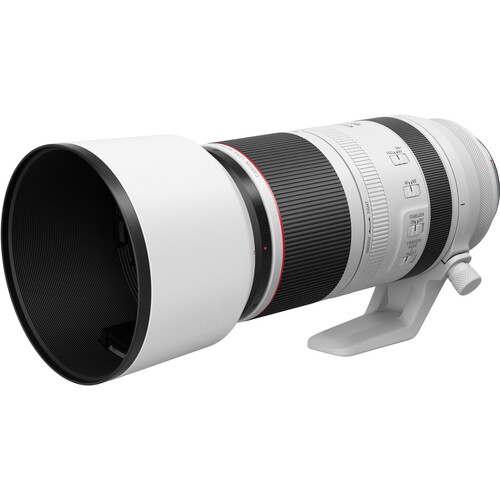
Technical Specifications:
- Type: Zoom Telephoto Lens
- Mount: Canon RF-Mount Lens/Full-Frame Format
- Focal Length: 100-500mm
- Aperture Range: f/4.5-7.1 to f/32-54
- Image Stabilization: Yes (Up to 5 stops)
- Minimum Focusing Distance: 2.6 ft. (0.79 m)
- Filter Diameter: 77mm
- Weather-Sealed Design: Fluorine Coating
- Weight: 3.0 lbs. / 1.365 kg.
- One Super UD Element, Six UD Elements
- Dual Nano USM AF System
- Optical Image Stabilizer
- Customizable Control Ring
- Rotating Zoom Ring, Torque Adjustment
- Rounded 9-Blade Diaphragm
- Compatible with RF Extenders
Canon RF 100-500mm f/4.5-7.1L IS USM Lens
Key Features
- Impressive 5x Zoom Range (100mm-500mm): This range provides exceptional flexibility. You can capture wide landscape shots to establish the scene (transitioning with a wide zoom) and then seamlessly zoom in for tight wildlife portraits, eliminating the need to carry multiple lenses.
- Built-in Image Stabilization (IS): Canon’s renowned image stabilization system effectively combats camera shake, ensuring sharper images throughout the zoom range. This is particularly beneficial (transitioning with emphasis) when shooting at longer focal lengths (like 500mm) or using slower shutter speeds in lower-light situations.
- Weather-Sealed Construction: For outdoor adventures, the lens is built to withstand challenging conditions. Dust and moisture resistance provide peace of mind when shooting in unpredictable weather, allowing you to focus on capturing wildlife moments (transitioning with a benefit).
- Decent Low-Light Performance: While not the absolute best, the f/4.5 maximum aperture at the wide end (100mm) allows you to capture wildlife in moderately low-light situations. This provides some flexibility when those perfect wildlife encounters happen outside of ideal lighting conditions.
Pros
- Impressive Zoom Range: The 5x zoom range (100mm-500mm) offers great flexibility, allowing you to capture wide landscape shots of your environment and zoom in for close-up wildlife portraits. This eliminates the need to carry multiple lenses.
- Relatively Affordable: Compared to some high-end super telephoto lenses, the RF 100-500mm falls on the more budget-friendly side, making it accessible to a wider range of wildlife photographers.
- Image Stabilization: Canon’s built-in image stabilization (IS) effectively minimizes camera shake, ensuring sharper images, especially at longer focal lengths and slower shutter speeds.
- Weather-Sealed Construction: This lens is built to withstand challenging outdoor conditions. Dust and moisture resistance provide peace of mind when shooting in unpredictable weather.
- Decent Low-Light Performance: While not its strongest point, the f/4.5 maximum aperture at the wide end allows for capturing wildlife in moderately low-light situations.
Cons
- Variable Aperture: The maximum aperture narrows to f/7.1 at the telephoto end (500mm), affecting low-light capabilities and background blur (bokeh) at that focal length.
- Size and Weight: While lighter than some prime telephoto lenses, the RF 100-500mm can still be bulky and heavy, especially for extended handheld shooting. Consider a tripod or monopod for better support.
- Soft Corners: Some users report softer image quality, particularly at the corners of the frame, especially at the telephoto end. This might require adjustments in post-processing.
- Not Ideal for Fast Action: The slightly slower autofocus compared to some prime telephoto lenses might not be ideal for tracking very fast-moving wildlife.
Summary
The Canon RF 100-500mm f/4.5-7.1L IS USM lens is a great option for photographers who want to shoot high quality images of wildlife and nature. It’s a cost-effective and versatile telephoto zoom lens that works well with Canon RF mirrorless cameras.
This lens is particularly suitable for bird and wildlife photographers due to its flexible zoom range and ease of portability. It’s perfect for capturing wildlife on the move, and its image stabilization technology ensures that your photos are sharp and stable. Additionally, the lens has a weather-sealed design, making it ideal for use in various outdoor conditions.
Moreover, the lens supports the optional Extender RF 1.4x and Extender RF 2x teleconverters, which can extend the effective focal length of the 300-500mm segment of the lens. All of these features make the Canon RF 100-500mm f/4.5-7.1L IS USM lens an excellent option for photographers who want to shoot high-quality images of nature and wildlife.
4) Canon RF 200-800mm f/6.3-9 IS USM Lens
For wildlife Canon photographers in search of a revolutionary zoom lens to capture nature’s wonders, the Canon RF 200-800mm f/6.3-9 IS USM lens is a must-see. This game-changer boasts an extensive zoom range that completely transforms your approach to wildlife photography.
The 200-800mm range allows you to achieve detailed close-up portraits, ensuring superior image quality. From a majestic eagle soaring in the sky to a delicate hummingbird perched on a branch, this lens captures sharp details of feathers, fur, and other intricate features with remarkable clarity.
For bird enthusiasts, the Canon RF 200-800mm f/6.3-9 IS USM lens is an exciting tool. Its extensive zoom range allows you to capture a variety of bird behaviors in incredible detail, whether it’s the vibrant plumage of a colorful parrot or the dynamic wing movements of a hawk in mid-flight.
Furthermore, the lens is compact and lightweight, perfect for bird photography expeditions. This ensures you’re always prepared to capture spontaneous moments of wildlife interaction, even when venturing into challenging terrain.
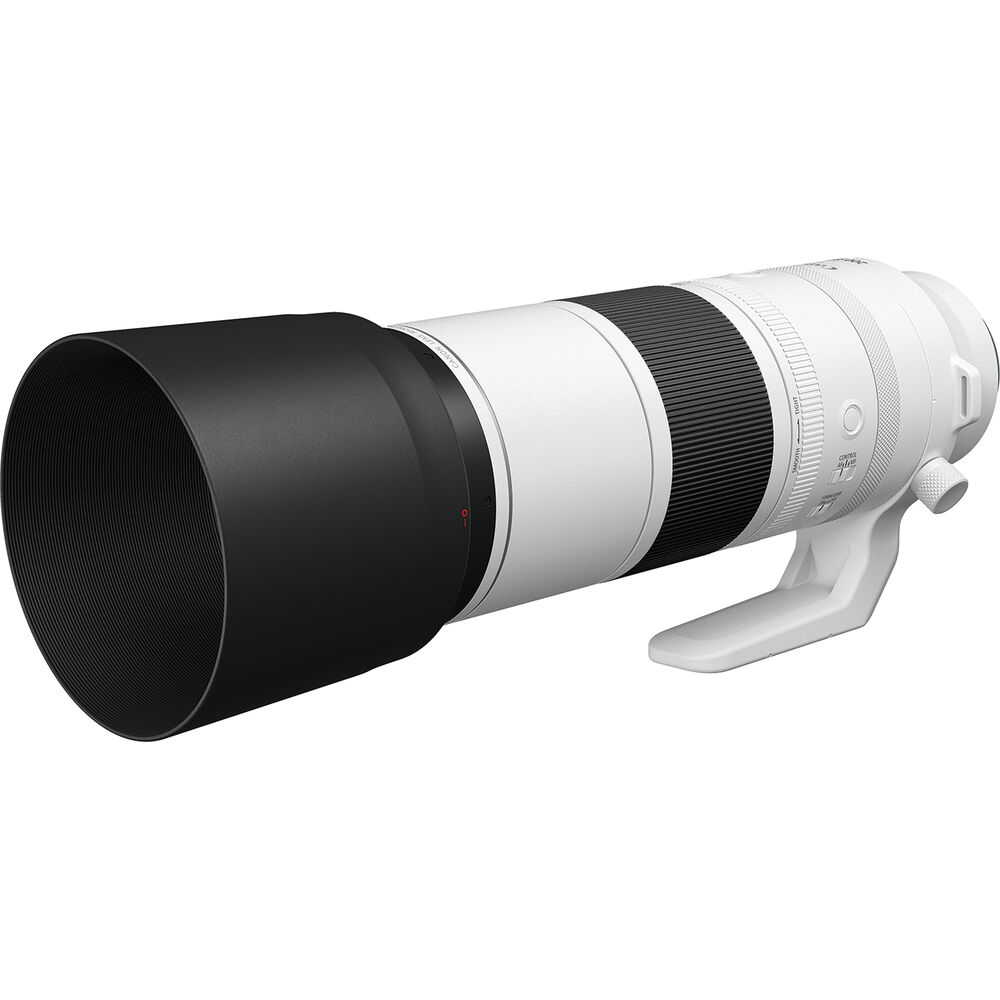
Technical Specifications:
- Type: Zoom Lens
- Mount: Canon RF
- Focal Length: 200-800mm
- Full-Frame: f/6.3-9 to f/54
- Image Stabilization: Yes (Optical Image Stabilizer with up to 5.5 stops of shake correction)
- Minimum Focusing Distance: 0.82 meters (2.7 feet)
- Filter Diameter: 95mm
- Weather-Sealing: Yes
- Weight: 4.52 lbs. / 2.05 kg
- Motor: Nano USM Motor
- Focus/Control Ring & Two L-Fn Buttons
- Optical Image Stabilizer
- 3 UD Elements
- Super Spectra Coating
Canon RF 200-800mm f/6.3-9 IS USM Lens
Key Features
- Unmatched Zoom Range (200-800mm): This lens sets itself apart with a truly exceptional zoom range. The 200-800mm range offers incredible versatility, allowing you to capture stunning close-up portraits of distant subjects, like a majestic bald eagle soaring high above, or frame tighter compositions of wildlife right in front of you, all with a single lens.
- Exceptional Image Quality Throughout: Despite the impressive zoom range, image quality doesn’t suffer. The RF 200-800mm f/6.3-9 IS USM lens maintains exceptional sharpness and clarity throughout the entire focal length. This ensures you capture every intricate detail, from the delicate patterns on a butterfly’s wing to the fierce glint in a predator’s eye, with remarkable precision.
- Surprisingly Compact and Lightweight (for a Super-Telephoto Lens): While telephoto lenses often come with significant bulk, the RF 200-800mm is surprisingly manageable. It’s lighter and more compact compared to other super-telephoto options. This makes it a more practical choice for wildlife photography expeditions, especially for birdwatchers who may be trekking through various terrains.
Pros
- Unprecedented Zoom Range (200-800mm): This lens offers exceptional versatility, allowing you to capture wildlife from a distance without disturbing them. You can achieve detailed close-up portraits of birds in flight, elusive mammals, or any creature in your sights, all with a single lens.
- Sharp Image Quality: Despite the extensive zoom range, the lens maintains impressive image quality throughout. Expect crisp details in feathers, fur, and other intricate features, ensuring stunning wildlife photographs.
- Lightweight and Compact (for its class): While still a telephoto lens, the RF 200-800mm is surprisingly lightweight and compact compared to similar super-telephoto options. This makes it easier to carry on wildlife photography expeditions, especially valuable for birdwatchers on the move.
- Image Stabilization: Canon’s built-in image stabilization (IS) effectively combats camera shake, enabling sharp images even at slower shutter speeds, often necessary in wildlife photography.
Cons
- Variable Aperture (f/6.3-9): The maximum aperture narrows as you zoom in, limiting low-light performance and background blur (bokeh) at the telephoto end (800mm). This might require adjusting shooting techniques or using higher ISO settings in low-light situations.
- Potentially High Cost: This is a high-end lens with a price tag to match. Depending on your budget and shooting needs, there might be more affordable telephoto options available.
- Not Ideal for Fast Action: While the lens focuses quickly, some users report it might not be as fast as dedicated prime telephoto lenses for tracking extremely fast-moving wildlife.
Summary: A Powerful Tool with Considerations
The Canon RF 200-800mm f/6.3-9 IS USM lens is a powerful tool for wildlife photographers, particularly those seeking exceptional zoom range and image quality. Its compact design and image stabilization make it a compelling option for birdwatchers and wildlife enthusiasts on the go. However, the variable aperture and potentially high cost are important factors to consider when making your decision.
If ultimate low-light performance or capturing very fast-action wildlife is your priority, a prime telephoto lens might be a better fit. Ultimately, the Canon RF 200-800mm f/6.3-9 IS USM lens offers exceptional versatility and image quality, but careful consideration of its strengths and weaknesses is crucial to ensure it aligns with your specific wildlife photography needs.
Canon EF Lenses (DSLR)
1) Canon EF 100-400mm f/4.5-5.6L IS II USM Lens:
As a wildlife photographer, I’m constantly searching for gear that bridges the gap between me and the captivating world of wild creatures. The Canon EF 100-400mm f/4.5-5.6L IS II USM lens has piqued my interest for its versatility and potential to elevate my wildlife and bird photography. Let’s delve into its key features, weigh the pros and cons, and see if it lives up to the hype.
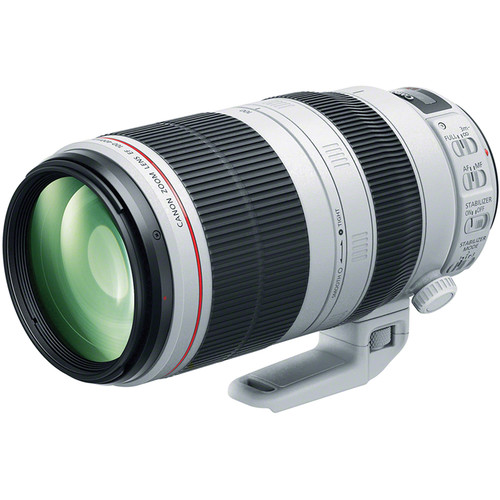
Technical Specifications:
- Type: Zoom Telephoto Lens
- Mount: Canon EF
- Focal Length: 100-400mm
- Aperture Range: f/4.5 to f/38
- Image Stabilization: Yes (Image Stabilizer)
- Minimum Focusing Distance: 3.1 ft. (0.95 m)
- Filter Diameter: 77mm
- Weight: 3.46 lbs. / 1.57 kg
- EF-Mount Lens/Full-Frame Format
- One Fluorite and One Super UD Element
- Air Sphere Coating
- Ring-Type Ultrasonic Motor AF System
- Optical Image Stabilizer
- Rotating Zoom Ring & Torque Adjustment
- Weather-Sealed Design, Fluorine Coating
- Detachable, Rotatable Tripod Collar
- Rounded 9-Blade Diaphragm
Canon EF 100-400mm f/4.5-5.6L IS II USM Lens
Key Features:
- Impressive Zoom Range (100-400mm): This versatile zoom range allows you to adapt to various wildlife encounters. You can seamlessly switch from capturing wider landscape shots to framing tighter close-up portraits of birds or animals, all within the same lens (transition highlighting a key feature). This eliminates the need to carry multiple lenses and ensures you always prepared for spontaneous wildlife moments.
- Image Stabilization for Sharp Results: Nature rarely provides ideal lighting or perfectly still subjects. The Canon EF 100-400mm f/4.5-5.6L IS II USM lens incorporates Canon’s renowned image stabilization (IS) technology. This helps combat camera shake, especially at slower shutter speeds often needed in wildlife photography, resulting in sharper images and reduced blur (transition explaining benefits).
- Fast and Accurate Autofocus: The ability to quickly focus on unpredictable wildlife is crucial. This lens boasts a fast and accurate autofocus system, ensuring you capture those fleeting moments of action or a bird in perfect flight (transition highlighting another key feature).
Pros
- Versatile zoom range for various wildlife encounters
- Image stabilization for sharper wildlife photos
- Fast and accurate autofocus to capture fleeting moments
Cons
- Variable aperture (f/4.5-5.6) might limit low-light performance
- Not the most compact or lightweight telephoto lens
- Although this lens is great for wildlife enthusiasts, professional photographers aiming for the highest image quality may encounter limitations, especially in low-light conditions where utmost sharpness and clarity are essential.
- The variable aperture might not provide the desired shallow depth of field needed for stunning bokeh effects.
Summary
The Canon EF 100-400mm f/4.5-5.6L IS II USM lens strikes a compelling balance between versatility, affordability, and performance for wildlife photographers. The zoom range, image stabilization, and autofocus system make it a valuable companion for capturing a variety of wildlife moments. However, photographers prioritizing low-light performance, ultimate image quality, or an extremely compact telephoto lens might need to consider alternative options.
Ultimately, the Canon EF 100-400mm f/4.5-5.6L IS II USM lens offers a well-rounded feature set for wildlife enthusiasts who want to elevate their nature photography without breaking the bank.
2) Canon EF 200-400mm f/4L IS USM Extender 1.4x
For wildlife photographers in the US, capturing the wild demands a lens that can keep pace with the action. The Canon EF 200-400mm f/4L IS USM Extender 1.4x lens has emerged as a favorite among enthusiasts for its impressive reach and professional-grade features. Let’s delve into its key features, weigh the pros and cons, and see if it lives up to the hype for photographing American wildlife.
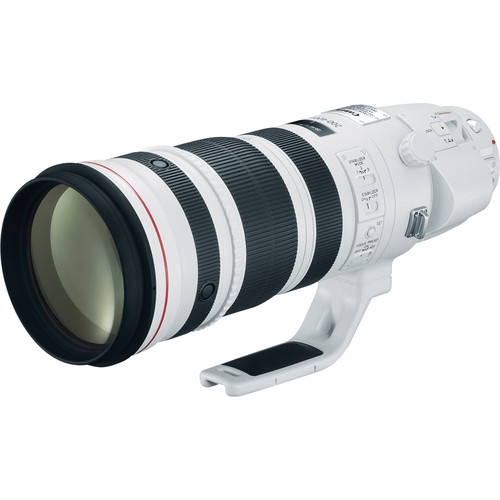
Technical Specifications:
- Type: Zoom Telephoto Lens
- Mount: Canon EF
- Focal Length: 200-400mm (280-560mm with extender engaged)
- Maximum Aperture: f/4 (f/5.6 with extender engaged)
- Image Stabilization: Yes (Image Stabilizer)
- Minimum Focusing Distance: 6.56 ft. (2.0 m)
- Filter Diameter: 77mm
- Weight: 7.98 lbs. / 3.62 kg
Canon EF 200-400mm f/4L IS USM Extender 1.4x
Key Features
- Exceptional Reach (280-560mm with Extender): This lens boasts a truly impressive zoom range; but the magic lies in the built-in 1.4x extender (transition highlighting a key feature). With a simple switch, you can extend the focal length to a staggering 560mm, bringing those distant bald eagles soaring on high currents or elusive mountain lions perched on rocky outcrops dramatically closer.
- Sharpness and Clarity: For wildlife photography, where sharpness and clarity are essential, this Canon lens stands out with its superior optics and a consistent f/4 maximum aperture across the zoom range, ensuring top-notch image quality. Photographers can anticipate capturing the intricate details of feathers, fur, and natural landscapes, bringing the stunning beauty of the American wilderness to life in their images
- Image Stabilization for Steady Shots: Ideal lighting and static poses are uncommon in wildlife photography. The Canon EF 200-400mm f/4L IS USM Extender 1.4x lens boasts Canon’s acclaimed image stabilization (IS) technology. This technology is crucial for countering camera shake, particularly at the slower shutter speeds required in dimly lit environments, ensuring crisper images with minimal blur.
Pros
- Exceptional reach with built-in 1.4x extender for distant wildlife
- Professional-grade image quality for stunning wildlife photos
- Image stabilization for sharp results in various lighting conditions
Cons
- Significant cost, a high-end lens for serious photographers
- Bulky and heavy, requires a tripod for extended use
- Not ideal for fast-paced action due to autofocus limitations
Summary
The Canon EF 200-400mm f/4L IS USM Extender 1.4x lens caters to serious wildlife photographers in the US seeking a powerful tool to capture the grandeur of American wildlife. The impressive reach with the extender, exceptional image quality, and image stabilization makes it a compelling option for those who prioritize professional-grade results. However, the significant cost, weight, and potential autofocus limitations in fast-paced scenarios require careful consideration before investing.
3) Canon EF 600mm f/4L IS USM Lens
For wildlife and bird photographers in the US, capturing the breathtaking details of our diverse fauna often requires exceptional reach. The Canon EF 600mm f/4L IS USM Lens stands out as a legendary super-telephoto lens, offering unparalleled magnification to bring distant subjects into the frame. Let’s explore its key features, weigh the pros and cons, and see if it’s the perfect fit for photographing American wildlife.
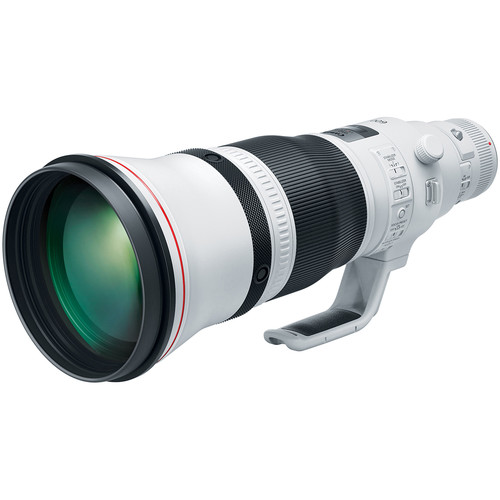
Technical Specifications:
- Type: Prime Telephoto Lens
- Mount: Canon EF
- Focal Length: 600mm
- Maximum Aperture: f/4
- Image Stabilization: Yes (Image Stabilizer)
- Minimum Focusing Distance: 13.5 ft. (4.1 m)
- Filter Diameter: Drop-in Filter
- Weight: The lens itself weighs around 11.83 lbs / 5.36 kg However, you likely won’t use it with the 1.4x extender attached all the time, so let’s break down the weight of each component:
- Canon Extender EF 1.4x III: (Approximate weight based on similar extenders) 0.3 kg (0.66 lbs)
- Total weight with Extender 1.4x attached:
- Pounds: 11.83 lbs (lens) + 0.66 lbs (extender) = 12.49 lbs
- Kilograms: 5.36 kg (lens) + 0.3 kg (extender) = 5.66 kg
Canon EF 600mm f/4L IS III USM Lens
Key Features
- Unmatched Focal Length (600mm): This lens boasts a staggering 600mm focal length, bringing faraway subjects incredibly close. Imagine framing tight close-up portraits of bald eagles in their nests high atop trees or capturing the intricate wing patterns of a hummingbird hovering near a feeder in stunning detail, all without physically disturbing the wildlife.
- Professional-Grade Image Quality: Wildlife photography thrives on sharp, high-resolution images. The Canon EF 600mm f/4L IS USM Lens utilizes top-tier optics and a large f/4 maximum aperture throughout the focal range to deliver exceptional image quality. Expect crisp details in feathers, fur, and scales, ensuring your photographs showcase the true beauty and intricacies of American wildlife.
- Image Stabilization for Critical Moments: Wildlife encounters are rarely perfectly still. This Canon lens features Canon’s renowned image stabilization technology (IS). This combats camera shake, especially at slower shutter speeds often needed in wildlife photography, resulting in sharper images and reduced blur, even in those fleeting moments of action.
Pros
- Unmatched focal length for capturing distant wildlife in exceptional detail
- Professional-grade image quality for stunning wildlife photographs
- Image stabilization for sharp results in various lighting conditions
Cons
- Extremely high cost, a premium lens for professional photographers
- Significant weight and bulk require a sturdy tripod for support
- Autofocus might not be ideal for very fast-paced action sequences
Canon Lens Summary
Canon Mirrorless Lenses
For wildlife photographers seeking exceptional reach, the Canon RF 800mm f/5.6 L IS USM Lens stands out as a top choice, offering unparalleled magnification for capturing distant subjects with stunning clarity. Its impressive focal length is complemented by advanced image stabilization, ensuring sharp shots even in challenging conditions.
The Canon RF 600mm f/4L IS USM Lens provides a slightly shorter focal length but maintains superb image quality and stabilization, making it a versatile option for capturing wildlife in various settings.
Photographers looking for flexibility without compromising on image quality may find the Canon RF 100-500mm f/4.5-7.1L IS USM Lens to be an ideal choice. Its zoom range allows for a wide range of compositions, while image stabilization helps maintain sharpness throughout the focal range.
The Canon RF 200-800mm f/6.3-9 IS USM Lens offers an impressive telephoto reach, making it well-suited for capturing distant wildlife. However, its variable aperture may require photographers to adjust settings in changing light conditions.
Canon DSLR Lenses
For those using Canon EF mount cameras, the Canon EF 100-400mm f/4.5-5.6L IS II USM Lens provides a versatile zoom range with excellent image quality and stabilization, making it a reliable choice for wildlife photography.
The Canon EF 200-400mm f/4L IS USM Extender 1.4x combines a long focal length with a built-in extender, offering even greater reach for capturing distant subjects. This lens is well-suited for photographers who require maximum telephoto capabilities.
Finally, the Canon EF 600mm f/4L IS USM Lens offers exceptional image quality and stabilization, making it a top choice for wildlife photographers who prioritize performance and image quality above all else.
Ultimately, the choice of lens will depend on individual preferences and shooting needs. Wildlife photographers should consider factors such as focal length, aperture, image stabilization, and compatibility with their camera system when selecting a lens for their kit.
Top Nikon Lens picks for Wildlife Photography
Mirrorless
- Nikon NIKKOR Z 400mm f/4.5 VR S Lens:
- Nikon NIKKOR Z 100-400mm f/4.5-5.6 VR S Lens:
- Nikon NIKKOR Z 180-600mm f/5.6-6.3 VR S Lens:
- Nikon NIKKOR Z 600mm f/6.3 VR S Lens:
DSLR
- Nikon AF-S NIKKOR 200-500mm f/5.6E ED VR Lens:
- Nikon AF-S NIKKOR 500mm f/5.6E PF ED VR Lens:
- Nikon AF-S NIKKOR 800mm f/5.6E FL ED VR:
Nikon offers an extensive range of lenses that are compatible with both their DSLR (F-mount) and mirrorless (Z-mount) camera systems. These lenses are available in various price ranges and cater to different shooting styles, making it easy for you to find the perfect lens that suits your budget and preferences for capturing wildlife photography.
In the following section, we will discuss the specific lens required for wildlife photography, which will help you identify the ideal Nikon lens to bring your wildlife photography vision to life.
Nikon Z Lenses (Mirrorless)
1) Nikon NIKKOR Z 400mm f/4.5 VR S Lens
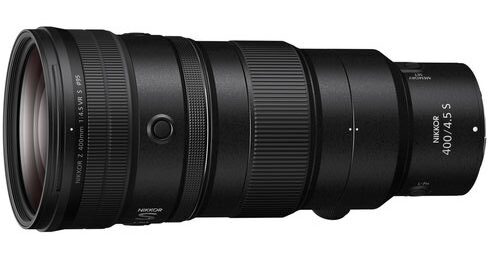
Technical Specifications:
- Type: Fixed / Prime Telephoto Lens
- Mount: Lens/FX Format
- Focal Length: 400mm
- Aperture Range: f/4.5 to f/32
- Image Stabilization: Yes (VR – Vibration Reduction)
- Minimum Focusing Distance: 6.6 ft. (2.0 m)
- Filter Diameter: 95mm
- Weather-Sealing: Yes, Fluorine Coating
- Weight: 2.74 lbs. /1.24 kg
- Rotating Tripod Collar
- Rounded 9-Blade Diaphragm
- SR, Super ED, and ED Elements
- Nano Crystal Coat
- Stepping Motor AF System
- Vibration Reduction Image Stabilization
- Customizable Fn and Memory Set Buttons
Nikon NIKKOR Z 400mm f/4.5 VR S Lens
Capture Wildlife Encounters in Stunning Detail
The advent of mirrorless cameras has opened up new possibilities for wildlife and bird photographers. The Nikon NIKKOR Z 400mm f/4.5 VR S Lens is a powerful contender in this field, offering exceptional reach and performance in a compact and lightweight design tailored specifically for mirrorless systems. In this article, we’ll take a closer look at its key features, weigh the pros and cons, and see if this lens is the ideal tool to elevate your wildlife photography adventures across the diverse landscapes of the US.
Key Features
- Impressive Focal Length (400mm): This lens boasts a substantial 400mm focal length, bringing distant wildlife subjects remarkably close. Imagine capturing captivating close-up portraits of soaring bald eagles or framing tight compositions of elusive mountain lions, all without needing to physically get closer and potentially disturb the animals.
- Lightweight and Compact Design for Mirrorless Systems: Unlike traditional super-telephoto lenses, the NIKKOR Z 400mm f/4.5 VR S leverages the mirrorless camera design to achieve a surprisingly compact and lightweight build. This makes it a dream come true for wildlife photographers who value portability on long treks through diverse American landscapes.
- Superior Image Quality and Low-Light Performance: Sharpness and clarity are paramount for wildlife photography, especially in unpredictable lighting conditions. This Nikon lens utilizes high-quality optics and a large f/4.5 maximum aperture to deliver exceptional image quality. Expect crisp details even in low-light situations often encountered in the early mornings or late evenings, perfect for capturing those magical wildlife moments.
- Advanced Vibration Reduction (VR): Wildlife rarely cooperates with perfectly still poses. The NIKKOR Z 400mm f/4.5 VR S lens features Nikon’s advanced Vibration Reduction (VR) technology. This in-lens stabilization effectively combats camera shake, especially at slower shutter speeds needed in low-light wildlife photography, resulting in sharper images and reduced blur.
Pros
- Impressive focal length for capturing distant wildlife in detail
- Lightweight and compact design for mirrorless camera systems
- Superior image quality and low-light performance
- Advanced Vibration Reduction for sharp results in various lighting
Cons
- Potentially higher cost compared to some DSLR telephoto options
- Not the absolute longest reach compared to some super-telephoto lenses
- May require additional investment in a compatible Nikon Z series mirrorless camera body
- A Compelling Option for Mirrorless Wildlife Enthusiasts
Summary
The Nikon NIKKOR Z 400mm f/4.5 VR S Lens is an excellent option for wildlife and bird photographers in the USA who have embraced mirrorless cameras. Its impressive focal length, light-weight design, superior image quality, and advanced vibration reduction feature make it a powerful tool for capturing breathtaking wildlife moments. However, the potential cost, reach limitations compared to some super-telephoto lenses, and the need for a compatible camera body are crucial factors to consider before investing.
2) Nikon NIKKOR Z 100-400mm f/4.5-5.6 VR S Lens
For wildlife and bird photographers in the US, the Nikon NIKKOR Z 100-400mm f/4.5-5.6 VR S Lens is a tool that can truly elevate your photography adventures across American landscapes. This lens, with its versatility and performance, is capable of capturing the majesty of our diverse fauna in stunning detail. Let’s delve into its key features, pros and cons, and discover how it can inspire and enhance your wildlife photography.
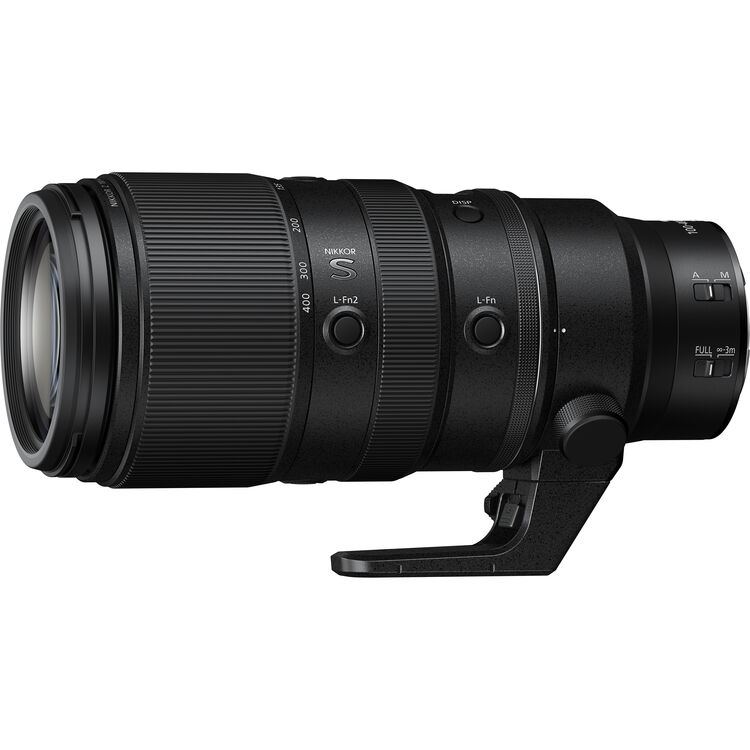
Technical Specifications:
- Type: Zoom Telephoto Lens
- Mount: Nikon Z
- Focal Length: 100-400mm
- Maximum Aperture: f/4.5 (at 100mm) – f/5.6 (at 400mm)
- Image Stabilization: Yes (VR – Vibration Reduction)
- Minimum Focusing Distance: 2.46 ft. (0.75 m)
- Filter Diameter: 77mm
- Weather-Sealing: Yes
- Weight: 3.1 lbs./ 1.4 kg
Nikon NIKKOR Z 100-400mm f/4.5-5.6 VR S Lens
Key Features
- Expansive Zoom Range (100-400mm): This lens boasts a versatile 100-400mm zoom range, offering exceptional flexibility for wildlife encounters (Transition: Specifying Feature). Imagine effortlessly switching from capturing wide landscape shots teeming with wildlife to framing tighter close-up portraits of birds in flight, all with a single lens (Transition: Highlighting Benefits for Wildlife Photography).
- Exceptional Image Quality: Sharpness and clarity are paramount for wildlife photography, ensuring you capture the intricate details that bring your subjects to life. The NIKKOR Z 100-400mm f/4.5-5.6 VR S employs high-quality optics to deliver exceptional image quality throughout the zoom range. Expect crisp details, allowing you to showcase the true beauty of American wildlife.
- Image Stabilization for Steady Results: Wildlife photography rarely occurs under perfectly still conditions. This Nikon lens features built-in Vibration Reduction (VR) technology. This combats camera shake, especially at slower shutter speeds often needed for wildlife photography in low-light situations, resulting in sharper images and reduced blur.
Pros
- Versatile zoom range for adapting to various wildlife encounters
- Excellent image quality for capturing stunning wildlife details
- Image stabilization for sharp photos in various lighting conditions
- Relatively compact and lightweight design compared to super-telephoto lenses
Cons
- Variable aperture (f/4.5-5.6) might limit low-light performance
- It may not offer the absolute longest reach for very distant wildlife
- It might not be ideal for professional photographers seeking the very best image quality
Summary
The Nikon NIKKOR Z 100-400mm f/4.5-5.6 VR S Lens is not just a lens; it’s a versatile and portable companion for wildlife photographers in the US.
Its expansive zoom range, excellent image quality, and image stabilization empower you to capture various wildlife moments confidently. While it may not be the absolute best in every aspect, it offers a compelling balance between versatility, portability, and performance.
3) Nikon NIKKOR Z 180-600mm f/5.6-6.3 VR S Lens
For wildlife and bird photographers in the US, capturing the captivating details of our diverse fauna often requires a lens that bridges the gap between impressive reach and portability. Enter the Nikon NIKKOR Z 180-600mm f/5.6-6.3 VR S Lens, a powerful contender that emerges as a compelling option for photographers seeking exceptional focal length and versatility in a mirrorless camera system. Let’s delve deeper into its key features, weigh the pros and cons, and see if it’s the ideal tool to elevate your wildlife photography adventures across the vast landscapes of the US.
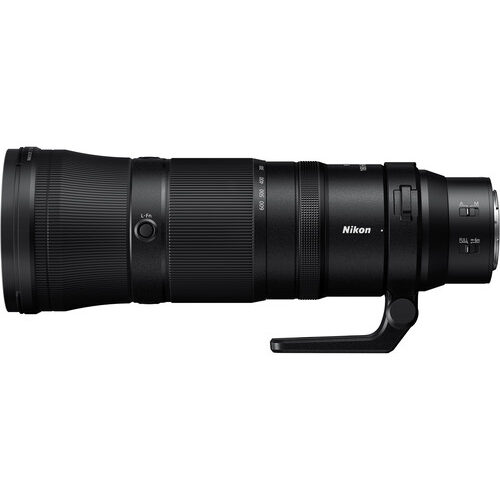
Technical Specifications:
- Type: Zoom Telephoto Lens
- Mount: Nikon Z
- Focal Length: 180-600mm
- Maximum Aperture: f/5.6 (at 180mm) – f/6.3 (at 600mm)
- Image Stabilization: Yes (VR – Vibration Reduction)
- Minimum Focusing Distance: 1.3 m (at 180mm) / 2.4 m (at 600mm)
- Filter Diameter: 95mm
- Weather-Sealing: Yes
- Weight: 4.3 lbs / 1.95 kg
Nikon NIKKOR Z 180-600mm f/5.6-6.3 VR S Lens
Key Features
- The Nikon NIKKOR Z 180-600mm f/5.6-6.3 VR S Lens is impressive; its reach truly stands out. Because of its 180-600mm range, you can photograph distant wildlife without disturbing them. For example, you can capture detailed wing patterns of hummingbirds near feeders with ease. Additionally, you can frame close-up portraits of bald eagles in treetop nests—without getting too close.
- Exceptional Image Quality Across the Zoom Range: Wildlife photography thrives on sharp, high-resolution images to showcase the true beauty of nature (Transition: Importance of Image Quality). The Nikon NIKKOR Z 180-600mm f/5.6-6.3 VR S employs high-quality optics to deliver exceptional image quality throughout the 180-600mm zoom range. Expect crisp details, ensuring your wildlife photographs come alive.
- Image Stabilization for Critical Moments: Since wildlife rarely stays still, this Nikon lens includes built-in Vibration Reduction (VR) to help stabilize your shots. As a result, it reduces blur and camera shake, especially at slower shutter speeds common in wildlife photography. Furthermore, it ensures sharper images during quick, unpredictable moments in the wild.
Pros
- Unmatched focal length for capturing distant wildlife in exceptional detail
- Excellent image quality throughout the entire zoom range
- Image stabilization for sharp photos in various lighting conditions
- Relatively compact and lightweight design compared to traditional super-telephoto lenses
Cons
- A slower variable aperture (f/5.6-6.3) might limit low-light performance
- It may not be ideal for professional photographers seeking the absolute best image quality
- Potentially higher cost compared to some other telephoto lens options
Summary: – A Powerful Tool for Serious Wildlife Enthusiasts
The Nikon NIKKOR Z 180-600mm f/5.6-6.3 VR S Lens is a powerful tool for serious wildlife photographers in the US seeking exceptional reach and versatility in a mirrorless camera system. The unmatched focal length, excellent image quality across the zoom range, and image stabilization make it a compelling option for capturing breathtaking wildlife moments.
However, photographers who prioritize low-light performance or absolute top-tier image quality might need to consider alternative options, while the variable aperture and potential cost are also important factors to weigh before investing in this lens.

4) Nikon NIKKOR Z 600mm f/6.3 VR S Lens
As a wildlife or bird photographer in the US, capturing the essence of diverse fauna can be a challenging task. In such cases, having a lens that provides exceptional performance and reach becomes crucial. The Nikon NIKKOR Z 600mm f/6.3 VR S Lens is a premium super-telephoto lens that offers unmatched performance in a mirrorless camera system. In this article, we will explore its key features, weigh its pros and cons and see if it is the perfect tool to enhance your wildlife photography adventures across the vast landscapes of the US.
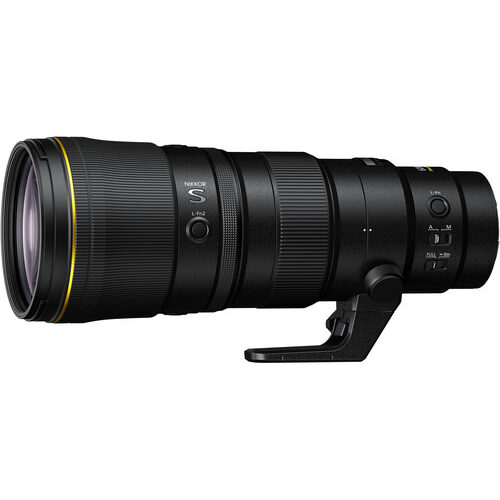
Technical Specifications:
- Type: Fixed / Prime Telephoto Lens
- Mount: Nikon Z
- Focal Length: 600mm
- Maximum Aperture: f/6.3
- Image Stabilization: Yes (VR – Vibration Reduction)
- Minimum Focusing Distance: 4.0 meters (13.1 feet)
- Filter Diameter: 95mm
- Weather-Sealing: Yes
- Weight: 3.24 lbs. / 1.47 kg
Nikon NIKKOR Z 600mm f/6.3 VR S Lens
Key Features
- Unmatched Focal Length (600mm): This lens has a staggering 600mm focal length, bringing distant wildlife subjects incredibly close for captivating close-up portraits. Imagine framing tight compositions of soaring Bald Eagles or capturing the intricate details of a perched hawk without disturbing their natural habitat.
- Lightweight and Compact Design for Mirrorless Systems: Unlike traditional super-telephoto lenses, the NIKKOR Z 600mm f/6.3 VR S leverages the mirrorless design for a surprisingly lightweight and compact build. This makes it ideal for wildlife photographers who prefer portability on long treks through diverse American landscapes.
- Superior Image Quality and Image Stabilization: Sharpness and clarity are paramount for wildlife photography, and the NIKKOR Z 600mm f/6.3 VR S delivers exceptional results in both aspects. The lens incorporates high-quality optics and Nikon’s advanced Vibration Reduction (VR) technology. You can expect crisp details, even in low-light conditions, ensuring sharp images free from camera shake.
Pros
- Unmatched focal length for capturing distant wildlife in stunning detail
- Lightweight and compact design ideal for mirrorless cameras and treks
- Superior image quality and image stabilization for sharp wildlife photographs
Cons
- Potentially higher cost compared to some telephoto lens options
- Not the fastest aperture (f/6.3), which can limit low-light performance
- May require a tripod for extended use due to the focal length
Summary: – A Powerful Tool for Dedicated Wildlife Enthusiasts
If you’re a wildlife photography enthusiast, the Nikon NIKKOR Z 600mm f/6.3 VR S is a lens that you should consider adding to your gear. It is a super-telephoto lens that allows you to capture stunning close-up shots of wildlife while maintaining a safe distance. With a focal length of 600mm, you can get up close and personal with your subjects without disturbing them, which is important for capturing natural and candid moments.
One of the best things about this lens is how lightweight and easy to handle it is. This makes it perfect for capturing sharp images, even in low-light conditions. You can easily carry it with you on long hikes or treks through the wilderness without feeling weighed down.
Overall, the Nikon NIKKOR Z 600mm f/6.3 VR S is an excellent lens for wildlife photographers who want to take their craft to the next level. Its combination of power, versatility, and portability make it a must-have for anyone who wants to capture the beauty and wonder of the natural world. However, it is important to keep in mind that in low light situations, the lens may not perform optimally due to its f/6.3 aperture.
1) Nikon F Lenses (DSLR)
Nikon AF-S NIKKOR 200-500mm f/5.6E ED VR Lens
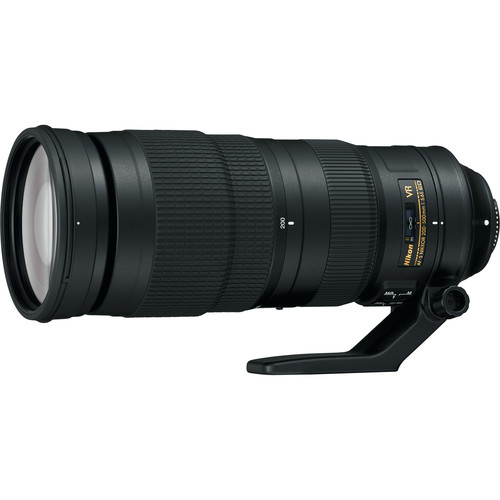
Technical Specifications:
- Type: Zoom Telephoto Lens
- Mount: Nikon F
- Focal Length: 200-500mm
- Maximum Aperture: f/5.6 (throughout the zoom range)
- Image Stabilization: Yes (VR – Vibration Reduction)
- Minimum Focusing Distance: 2.5 feet (0.75 m)
- Filter Diameter: 95mm
- Weather-Sealing: No
- Weight: 5.07 lbs. / 2.3 kg
Nikon AF-S NIKKOR 200-500mm f/5.6E ED VR Lens
Nikon AF-S NIKKOR 200-500mm f/5.6E ED VR Lens
For wildlife and bird photographers in the US, capturing the breathtaking details of our diverse fauna often requires a versatile lens that balances reach and affordability. The Nikon AF-S NIKKOR 200-500mm f/5.6E ED VR Lens is a compelling option for various wildlife encounters across the vast American landscapes. Let’s delve deeper into its key features, weigh the pros and cons, and see if it’s the ideal tool to elevate your wildlife photography adventures.
Key Features
- Versatile Zoom Range (200-500mm): This lens boasts a versatile 200-500mm zoom range, providing flexibility for wildlife photography. With a single lens, you can effortlessly switch from capturing wide landscape shots teeming with wildlife to framing tighter close-up portraits of birds in flight.
- Excellent Image Quality with ED Glass: Sharpness and clarity are paramount for wildlife photography, ensuring you capture the intricate details that bring your subjects to life. The NIKKOR 200-500mm f/5.6E ED VR employs Extra-low Dispersion (ED) glass to deliver exceptional image quality, minimizing chromatic aberration and color fringing throughout the zoom range. Expect crisp details in feathers, fur, and scales, allowing you to showcase the true beauty of American wildlife.
- Vibration Reduction for Steady Results: Wildlife photography rarely occurs under perfectly still conditions. This Nikon lens features built-in Vibration Reduction (VR) technology. This combats camera shake, especially at slower shutter speeds often needed for wildlife photography in low-light situations, resulting in sharper images and reduced blur.
- Durability and Weather-Sealed Design: The unforgiving outdoors can challenge your gear. The Nikon AF-S NIKKOR 200-500mm f/5.6E ED VR Lens features a durable build with a weather-sealed design. This provides peace of mind when photographing wildlife in unpredictable weather conditions, so you can focus on capturing the perfect shot.
Pros
- Versatile zoom range for adapting to various wildlife encounters
- Excellent image quality with ED glass for sharp wildlife photos
- Vibration Reduction (VR) for combating camera shake
- Durable build and weather-sealed design for outdoor use
Cons
- Variable aperture (f/5.6) might limit low-light performance
- Not the most compact or lightweight telephoto zoom lens
- It may not offer the absolute longest reach for very distant wildlife
Summary: – A Well-Rounded Choice for Wildlife Enthusiasts
The Nikon AF-S NIKKOR 200-500mm f/5.6E ED VR Lens strikes a compelling balance between versatility, affordability, and image quality for wildlife photographers in the US. The versatile zoom range, excellent image quality with ED glass, vibration reduction, and durable weather-sealed build makes it a well-rounded choice for capturing various wildlife moments across American landscapes. However, photographers prioritizing low-light performance, extreme reach, or the most compact design might need to consider alternative options. The absence of weather sealing also requires extra caution in adverse shooting environments.
2) Nikon AF-S NIKKOR 500mm f/5.6E PF ED VR Lens:
For wildlife and bird photographers in the US, capturing the captivating details of our diverse fauna often demands a lens that bridges the gap between exceptional reach and portability. Enter the Nikon AF-S NIKKOR 500mm f/5.6E PF ED VR Lens, a premium super-telephoto lens designed to bring distant wildlife subjects incredibly close. Let’s explore its key features, weigh the pros and cons, and see if it’s the ideal tool to elevate your wildlife photography adventures across the vast landscapes of the US.
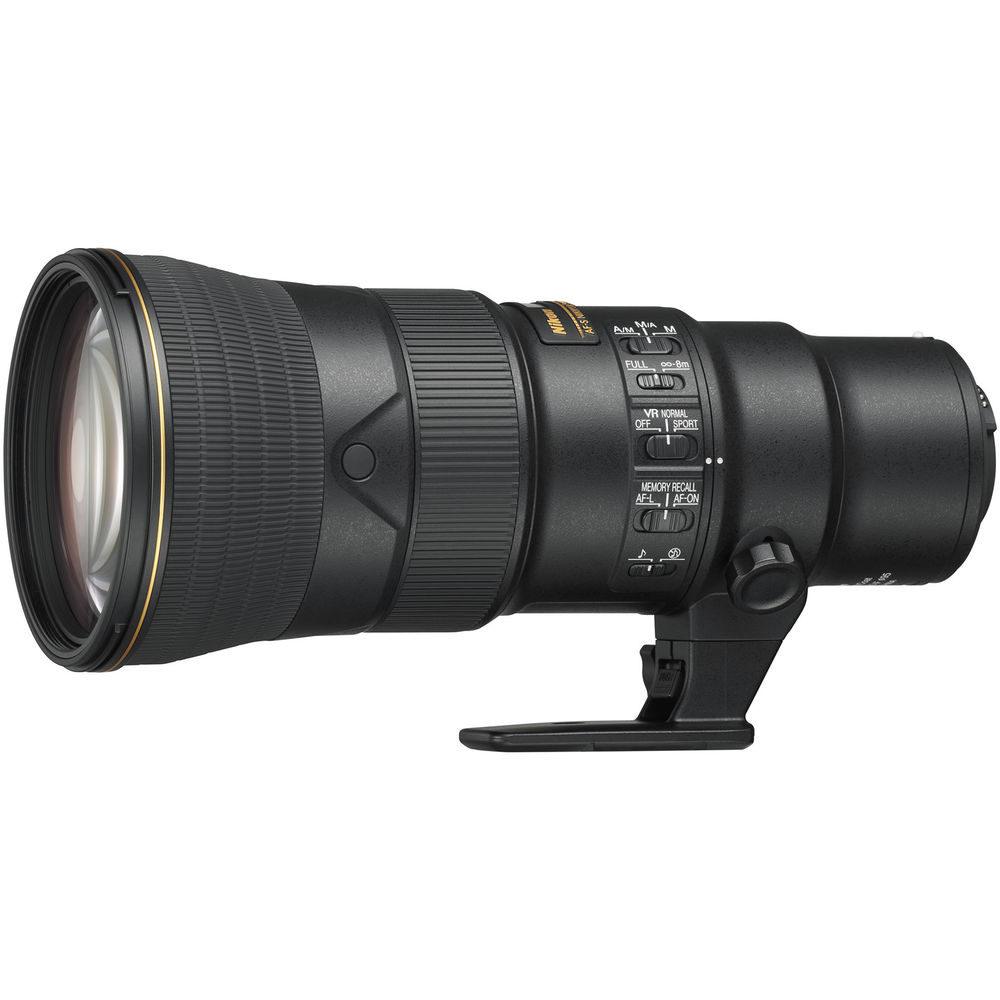
Technical Specifications:
- Type: Fixed / Prime Telephoto Lens
- Mount: Nikon F
- Focal Length: 500mm
- Maximum Aperture: f/5.6
- Image Stabilization: Yes (VR – Vibration Reduction)
- Minimum Focusing Distance: 3 meters (9.8 feet)
- Filter Diameter: 95mm
- Weather-Sealing: Yes
- Weight: 3.2 lbs. / 1.46 kg
- One Phase Fresnel Element
- Three Extra-Low Dispersion Elements
- Nano Crystal & Super Integrated Coatings
- Fluorine-Coated Front Lens Element
- Silent Wave Motor AF System
- Vibration Reduction, Sport/Tripod Modes
- Electromagnetic Diaphragm Mechanism
- Detachable, Rotatable Tripod Collar
Nikon AF-S NIKKOR 500mm f/5.6E PF ED VR Lens
Key Features
- Impressive Focal Length (500mm): This lens boasts a substantial 500mm focal length, bringing distant wildlife subjects remarkably close for captivating close-up portraits. Imagine capturing stunning details of Bald Eagles soaring high above or revealing the intricate feather patterns of a perched hawk, all without needing to get closer and potentially disturb the animals physically.
- The AF-S NIKKOR 500mm f/5.6E PF ED VR is a super-telephoto lens with Nikon’s unique Phase Fresnel (PF) technology. As a result, it is lightweight and compact, which is perfect for wildlife photographers who require portability on long hikes through different landscapes in America. This lens is a dream come true for them.
- Superior image quality and low-light performance are crucial for wildlife photography, particularly in unpredictable lighting conditions. This Nikon lens incorporates high-quality optics, ED (Extra-low Dispersion) glass, and a constant f/5.6 aperture to deliver exceptional image quality. You can expect sharp details and reduced chromatic aberration, even in low-light situations often encountered in the early mornings or late evenings, making it perfect for capturing those magical wildlife moments.
- Advanced Vibration Reduction (VR) technology is beneficial for wildlife photography. As animals rarely stay still, the in-lens stabilization feature effectively counters any camera shake, especially when shooting at slower shutter speeds in low-light conditions. This results in sharper images with reduced blurring.
Pros
- Impressive focal length for capturing distant wildlife in detail
- Lightweight and compact design for ease of use on treks
- Superior image quality and low-light performance
- Advanced Vibration Reduction for sharp results in various lighting
Cons
- Potentially higher cost compared to some telephoto lens options
- It is not the absolute longest reach compared to some super-telephoto lenses
Summary
The Nikon AF-S NIKKOR 500mm f/5.6E PF ED VR Lens is an excellent choice for photographers who are serious about capturing wildlife and bird shots in the US. This lens has an impressive focal length, is lightweight, provides superior image quality, and features advanced vibration reduction. It is a valuable tool for taking breathtaking wildlife photos across diverse landscapes. However, before investing, it is important to consider the potential cost and reach limitations compared to some prime super-telephoto lenses.
3) Nikon AF-S NIKKOR 800mm f/5.6E FL ED VR Lens
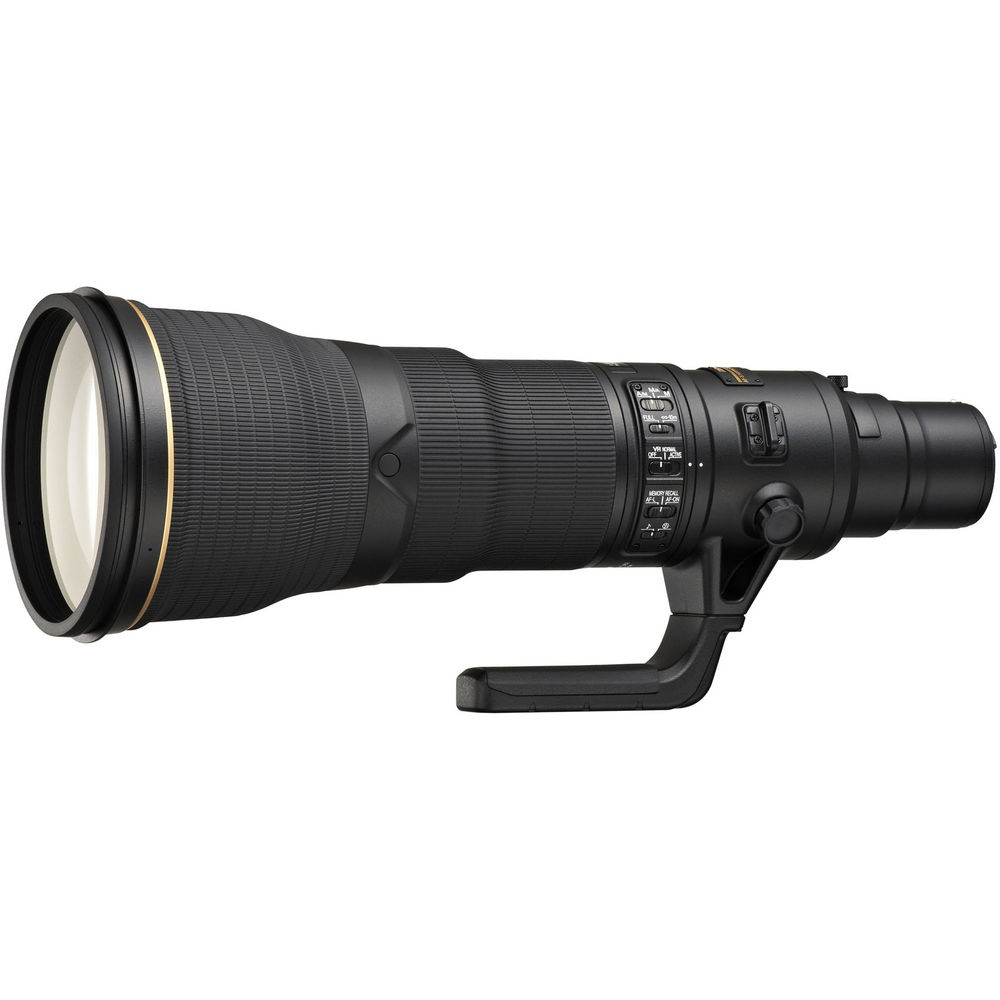
Technical Specifications:
- Type: Fixed / Prime Telephoto Lens
- Mount: Nikon F
- Focal Length: 800mm
- Maximum Aperture: f/5.6
- Image Stabilization: Yes (VR – Vibration Reduction)
- Minimum Focusing Distance: 5.9 meters (19.4 feet)
- Filter Diameter: 95mm
- Weather-Sealing: Yes
- Weight: 10.1 lbs. / 4.59 kg
Nikon AF-S NIKKOR 800mm f/5.6E FL ED VR Lens
Key Features
The Nikon AF-S NIKKOR 800mm f/5.6E FL ED VR reigns supreme in the super-telephoto domain, among wildlife photography lenses. Its formidable 800mm focal length shrinks vast distances, bringing even the most remote wildlife subjects into astonishingly close view. This enables the capture of stunningly detailed portraits without disturbing their natural habitat. Having tested this lens at PPA Imaging alongside the Nikon Z9, I was amazed. This lens definitely earned a spot on my wish list!
- Exceptional Sharpness: Beyond reach, this lens delivers phenomenal image quality. Advanced optics with fluorite and ED elements minimize color aberrations for stunning sharpness, clarity, and color fidelity across the entire frame. Even at f/5.6, it captures wildlife action and intricate details with impressive sharpness.
- Built to Withstand Anything: This lens is a workhorse for professional wildlife photography. The magnesium-alloy build balances outstanding durability with manageable weight. Weather sealing protects against dust, moisture, and harsh outdoor conditions. The Silent Wave Motor (SWM) ensures rapid, silent autofocus for precise tracking of elusive wildlife.
- Steady Shots Guaranteed: Nikon’s VR image stabilization provides up to 4 stops of shake reduction, minimizing camera shake at slower shutter speeds. Capture sharp handheld images in low-light or use slower shutter speeds for creative effects.
- A Dream Lens for Wildlife Pros: The Nikon AF-S NIKKOR 800mm f/5.6E FL ED VR is a significant investment, reflecting its premium quality. This lens is ideal for professional wildlife photographers and serious hobbyists demanding exceptional image quality, unmatched reach, and top-tier performance.
Pros
- Impressive focal length for capturing distant wildlife in detail
- Superior image quality and low-light performance
- Advanced Vibration Reduction for sharp results in various lighting
Cons
- Potentially higher cost compared to some telephoto lens options
- It is not the absolute longest reach compared to some super-telephoto lenses
- Due to its immense focal length and robust build, this is a relatively heavy and long lens.
- A sturdy tripod is practically essential for sharp images, especially at slower shutter speeds.
The Nikon AF-S NIKKOR 800mm f/5.6E FL ED VR represents a significant investment for dedicated wildlife photographers. As a premium super-telephoto lens, its cost is indicative of its superior capabilities. This lens is ideal for professional wildlife photographers and serious hobbyists who require unparalleled image quality, extensive reach, and outstanding performance.
Summary
The Nikon AF-S NIKKOR 800mm f/5.6E FL ED VR is a phenomenal super-telephoto prime lens. It is designed for professional wildlife photographers who demand the ultimate in reach, image quality, and performance. Its exceptional optics, robust build, and image stabilization features make it a powerful tool for capturing extraordinary wildlife images.
The fast f/5.6 aperture is excellent for low-light performance, and the VR image stabilization is top-notch. This lens is weather sealed for challenging outdoor conditions and boasts exceptional image quality. However, it comes at a significant price point and is quite heavy, requiring a sturdy tripod for optimal use.
Nikon Lens Overview
As a summary, Nikon offers a range of lenses for wildlife photographers using either mirrorless cameras like the Nikon Z series or DSLRs. The Nikon NIKKOR Z lenses are specifically designed for the Z mount, providing optimal performance and compatibility with the camera body.
Nikon Mirrorless Lenses
For mirrorless cameras, the Nikon NIKKOR Z 400mm f/4.5 VR S Lens provides excellent sharpness and image quality, making it ideal for capturing detailed wildlife shots. The VR feature helps reduce camera shake, which is beneficial for handheld shooting, especially in low-light conditions. The Nikon NIKKOR Z 100-400mm f/4.5-5.6 VR S Lens offers a versatile zoom range, allowing photographers to capture a variety of wildlife scenes. The VR feature enhances stability, and the lens delivers sharp images throughout the zoom range. For those seeking even greater reach, the Nikon NIKKOR Z 180-600mm f/5.6-6.3 VR S Lens and the Nikon NIKKOR Z 600mm f/6.3 VR S Lens provide extended focal lengths for capturing wildlife from a distance. Both lenses feature VR technology to minimize blur and deliver sharp images with beautiful bokeh.
Nikon DSLR Lenses
Regarding DSLR lenses, the Nikon AF-S NIKKOR lenses are also excellent for wildlife photography. The Nikon AF-S NIKKOR 200-500mm f/5.6E ED VR Lens provides a versatile focal length range and VR technology for stability. It’s a popular choice among wildlife photographers for its combination of reach and image quality.
The Nikon AF-S NIKKOR 500mm f/5.6E PF ED VR Lens is known for its compact and lightweight design. This makes it a great option for photographers who need a portable super-telephoto lens. The PF element helps reduce chromatic aberrations, and the VR feature enhances stability for sharp images.
For photographers who require the ultimate in reach, the Nikon AF-S NIKKOR 800mm f/5.6E FL ED VR Lens offers an incredible focal length for capturing wildlife from a considerable distance.
The FL and ED elements ensure sharpness and minimize chromatic aberrations, while the VR feature reduces camera shake for sharp images.
Summary
Nikon offers a range of lenses for wildlife photographers, whether they use mirrorless cameras or DSLRs. The choice between mirrorless and DSLR will depend on individual preferences and shooting requirements. Either way, these lenses provide the performance and versatility needed to capture stunning wildlife images.
Top Lenses for Sony Wildlife Photography
Mirrorless
- Sony FE 600mm f/4 GM OSS Lens
- Sony FE 200-600mm f/5.6-6.3 G OSS Lens
- Sony FE 70-200mm f/2.8 GM OSS II Lens
Sony’s mirrorless (FE) camera system offers a growing selection of high-performance lenses for wildlife photography. Here are some of their most compelling options for wildlife photography:
1) Sony FE 600mm f/4 GM OSS Lens
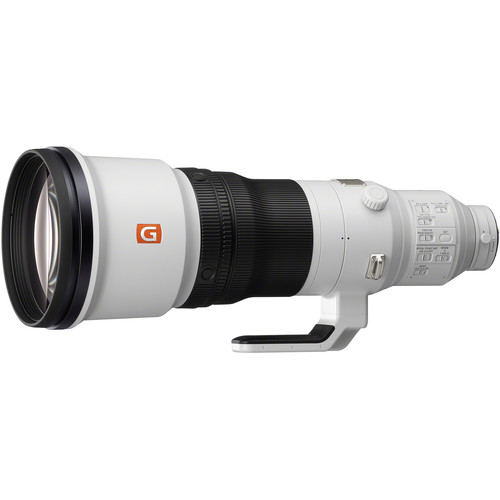
Technical Specifications:
- Type: Fixed / Prime Telephoto Lens
- Mount: Sony E
- Focal Length: 600mm
- Maximum Aperture: f/4
- Image Stabilization: Yes (OSS – Optical SteadyShot)
- Minimum Focusing Distance: 4.0 meters (13.1 feet)
- Filter Diameter: 95mm
- Weather-Sealing: Yes
- Weight: 6.7 lbs. / 3.04 kg
Sony FE 600mm f/4 GM OSS Lens
Key Features: – Unmissable Wildlife Encounters
The Sony FE 600mm f/4 GM OSS brings distant US wildlife incredibly close with its impressive 600mm focal length. Capture a Bald Eagle soaring over California or a Grizzly Bear fishing in Alaska – all without disturbing their habitat.
- Birds in Breathtaking Detail: This lens bridges vast distances for exquisite close-up portraits of birds across the US. Imagine capturing a Scarlet Macaw in the Everglades or a Great Horned Owl in the Rockies. Freeze the action of a hummingbird or showcase an eagle’s wingspan – all with stunning detail.
- Nature Photography Masterpiece: This lens is perfect for wildlife adventures across diverse landscapes. From powerful bison on the Great Plains to elusive bobcats in the Southwest, capture stunning wildlife portraits with exceptional detail.
- Exceptional Performance: This lens prioritizes exceptional image quality. The bright f/4 aperture excels in various lighting conditions. This allows for faster shutter speeds and sharper images, especially crucial in low-light environments. Expect exceptional sharpness, clarity, and minimized chromatic aberration.
- Lightweight Champion: Remarkably lightweight for a super-telephoto lens, the Sony FE 600mm f/4 GM OSS is easier to manage on wildlife photography adventures.
- Silent, Speedy Focus: This lens features Sony’s XD Linear Motors for exceptionally fast, quiet, and precise autofocus. This allows you to effortlessly track fast-moving wildlife and capture those decisive moments.
- Steady Shots, Sharp Results: Built-in image stabilization minimizes camera shake for sharp images even at slower shutter speeds.
- A Dream Lens for Wildlife Photographers: The Sony FE 600mm f/4 GM OSS is a professional-grade lens for serious photographers who demand the absolute best.
Pros
- Exceptional focal length for capturing distant wildlife in stunning detail
- Superior image quality and fast aperture for sharp low-light photos
- Lightweight and well-balanced design for mirrorless cameras
- Fast and precise autofocus system for capturing fleeting moments
- Built-in image stabilization for sharp results in various conditions
Cons
- Potentially high cost compared to some telephoto lens options
- While lighter than some super-telephoto lenses, a tripod is still recommended for extended shooting sessions or for situations where you need maximum image stability, especially at slower shutter speeds.
- The f/4 maximum aperture is good for low-light conditions, but you might still need to adjust ISO in very dim situations.
Summary
The Sony FE 600mm f/4 GM OSS Lens is a powerful tool for serious wildlife photographers in the US seeking a well-balanced combination of exceptional reach, image quality, and portability in a mirrorless system. The impressive focal length, superior image quality, fast autofocus, and built-in image stabilization make it ideal for capturing breathtaking wildlife moments across diverse landscapes. However, the potential cost and size are important factors to consider before investing.
2) Sony FE 200-600mm f/5.6-6.3 G OSS Lens:
A Versatile Super-Telephoto Zoom for Wildlife: The Sony FE 200-600mm f/5.6-6.3 G OSS is a versatile super-telephoto zoom lens that caters to a variety of wildlife photography needs. The impressive 200-600mm zoom range offers tremendous flexibility, allowing you to capture a wide variety of wildlife subjects, from tight close-up portraits of distant animals to wider environmental shots that showcase their habitat.
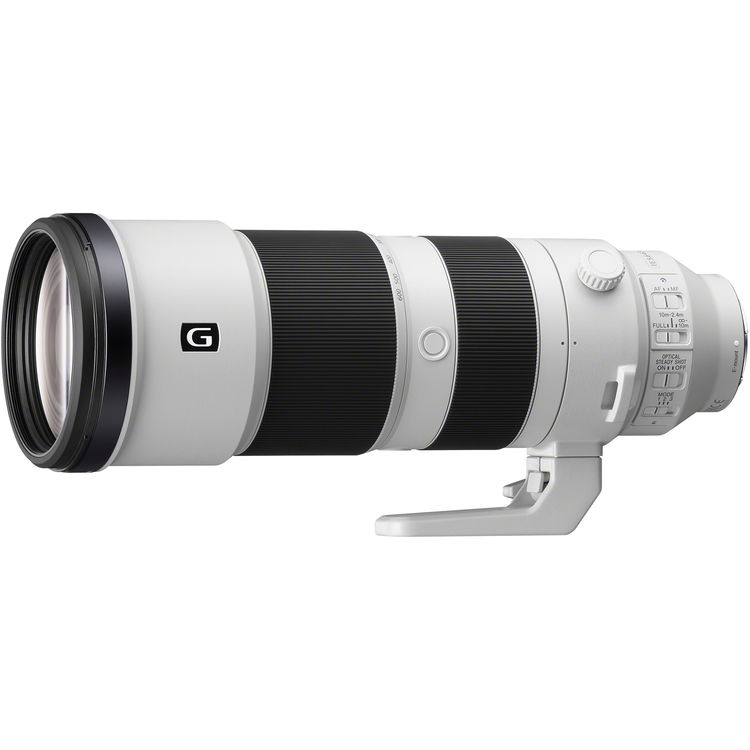
Technical Specifications:
- Type: Zoom Lens
- Mount: Sony E (mirrorless cameras)
- Focal Length: 200-600mm
- Maximum Aperture: f/5.6-6.3
- Image Stabilization: Yes (OSS – Optical SteadyShot)
- Minimum Focusing Distance: 7.87 ft (2.4 meters)
- Filter Diameter: 95mm
- Weather-Sealing: Yes
- Weight: 4.67 lbs./ 2.12 kg
Sony FE 200-600mm f/5.6-6.3 G OSS Lens
Key Features
- Bird Photography: This lens is well-suited for bird photography. The zoom range lets you capture a variety of bird behaviors, from the intricate details of a perched hummingbird to the powerful wingbeat of an eagle in flight.
- Travel Wildlife Photography: The versatile zoom range and manageable weight make this lens a good option for wildlife photography adventures. You can capture a wide range of subjects without needing to carry multiple lenses, which is especially beneficial when traveling or trekking through diverse locations.
- Sharp Optics and Good Image Quality: This lens delivers good image quality throughout the zoom range. The combination of ED (Extra-low Dispersion) glass elements and an aspherical element minimizes chromatic aberration and ensures sharp, clear images. While the maximum aperture narrows as you zoom in (f/5.6 at 200mm and f/6.3 at 600mm), it’s still good enough to capture wildlife in various lighting conditions.
- Impressively Light for a Super-Telephoto Zoom: For a super-telephoto zoom lens, the Sony FE 200-600mm f/5.6-6.3 G OSS is surprisingly lightweight, making it easier to carry on wildlife photography adventures. This is a significant advantage, especially when trekking through diverse terrains or shooting for extended periods.
- Fast and Quiet Focus for Capturing Decisive Moments: The lens features a Direct Drive SSM (Super Sonic wave Motor) autofocus system that delivers fast, quiet, and precise focusing performance. This is crucial for tracking fast-moving wildlife subjects and ensuring you capture those fleeting moments in sharp detail.
- Image Stabilization Advantage: Built-in Optical SteadyShot (OSS) image stabilization effectively minimizes camera shake, allowing you to capture sharp images at slower shutter speeds that are often necessary in wildlife photography. This is especially helpful when shooting at full zoom or in low-light situations.
- A Great Value for Wildlife Photography Enthusiasts: Compared to some higher-end super-telephoto lenses, the Sony FE 200-600mm f/5.6-6.3 G OSS is offered at a more affordable price point. This makes it a compelling option for wildlife photography enthusiasts who want a versatile zoom lens with good image quality and a telephoto reach that gets them closer to the action.
Pros and Cons:
Maximum Aperture: While good for various lighting conditions, the f/5.6-6.3 aperture might limit low-light performance somewhat compared to faster prime lenses. You might need to adjust ISO or use flash in very dim situations.
Tripod Recommended for Extended Use: A tripod is recommended for extended shooting sessions or situations where you need maximum image stability, especially at slower shutter speeds and full zoom.
Summary:
This Sony zoom lens is an excellent choice for wildlife photographers who use Sony mirrorless cameras. The impressive 200-600mm zoom range allows you to capture various subjects, from close-up portraits of large animals to distant birds in their natural habitat. The lens has an aperture range of f/5.6 to f/6.3, providing good low-light performance throughout the zoom range. Additionally, the built-in image stabilization feature ensures your photos remain sharp, even at slower shutter speeds. This lens offers the perfect balance of telephoto reach, zoom flexibility, and manageable weight for wildlife photographers who are always on the move.
3) Sony FE 70-200mm f/2.8 GM OSS II Lens
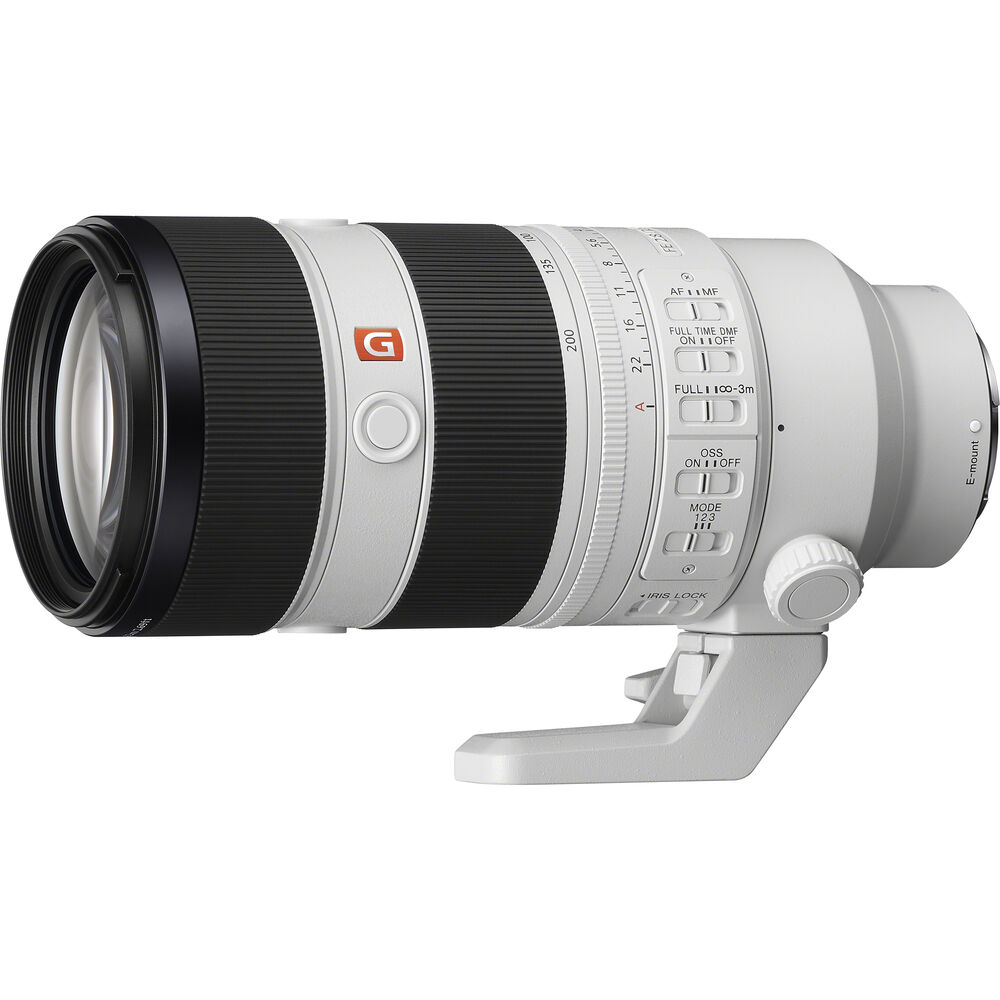
E-Mount Lens/Full-Frame Format
Aperture Range: f/2.8 to f/22
29% Weight Reduction from the Previous Model
Four XD Linear AF Motors; 4x Faster AF
One XA & One Aspherical Elements
Two ED Elements & Two Super ED Elements
Nano AR Coating II
Optical Steady Shot Image Stabilization
Dust and Moisture-Resistant Construction
Eleven-Blade Circular Diaphragm
Sony FE 70-200mm f/2.8 GM OSS II Lens
As a wildlife and bird photographer in the US, capturing the captivating behaviors and details of our diverse fauna often requires a versatile lens that balances portability and powerful zoom. The Sony FE 70-200mm f/2.8 GM OSS II Lens is a great choice as it offers a flexible zoom range and exceptional image quality in a well-balanced package.
This Sony G Master lens is an excellent companion for wildlife photography adventures across vast American landscapes. In this article, we will explore its key features, weigh the pros and cons, and see whether the FE 70-200mm f/2.8 GM OSS II Lens is the perfect tool to take your wildlife photography to the next level.
Key Features
- Versatile Zoom Range (70-200mm): The FE 70-200mm f/2.8 GM OSS II Lens boasts a versatile 70-200mm zoom range, providing valuable flexibility for various wildlife photography situations. With a single lens, you can effortlessly switch from capturing wide landscape scenes with wildlife to framing tighter close-up portraits of birds in flight.
- Superior Image Quality and Fast Aperture: Sharpness and clarity are paramount for wildlife photography, ensuring you capture the intricate details that bring your subjects to life. This Sony lens incorporates high-quality G Master optics and a large f/2.8 maximum aperture. Expect crisp details, beautiful bokeh effects, and excellent low-light performance, allowing you to capture those magical wildlife moments before sunrise or after sunset.
- Lightweight and Well-Balanced Design: Wildlife photography involves carrying your gear for long treks. The FE 70-200mm f/2.8 GM OSS II Lens prioritizes a lightweight and well-balanced design for comfortable portability. This makes maneuverability easier while on the go, ensuring you’re prepared to capture wildlife encounters throughout your adventures (Transition: Highlighting Benefits for Wildlife Photography).
- Fast and Precise Autofocus: The fast-paced world of wildlife photography demands a lens that can keep up. This Sony lens features a high-performance autofocus system with linear motors. Expect exceptional focus, speed, and precision to stay locked onto your subjects and confidently capture fleeting wildlife moments.
- Built-in Image Stabilization for Sharp Results: Camera shake can be detrimental to wildlife photography sharpness, especially at slower shutter speeds, which are often needed in low-light situations. The FE 70-200mm f/2.8 GM OSS II Lens features built-in Optical SteadyShot (OSS) image stabilization. This effectively combats camera shake, resulting in sharper images and reduced blur, even when using slower shutter speeds or handheld.
Pros and Cons to Consider:
Pros:
- Versatile zoom range for adapting to various wildlife encounters
- Superior image quality and fast aperture for sharp wildlife photos
- Lightweight and well-balanced design for comfortable portability
- Fast and precise autofocus system for capturing fleeting moments
- Built-in image stabilization for sharp results in various conditions
Cons:
- Potentially higher cost compared to some telephoto zoom lens options
- It is not the absolute longest reach for very distant wildlife
Summary:
The Sony FE 70-200mm f/2.8 GM OSS II Lens is a well-rounded choice for wildlife photographers in the US seeking a versatile and high-performing zoom lens. The combination of a flexible zoom range, excellent image quality, fast autofocus. The built-in image stabilization makes it a valuable companion for capturing captivating wildlife moments across diverse landscapes. However, photographers prioritizing a lower price point, or the absolute longest reach may need to consider alternative options.
Best Lenses for OM System Wildlife Photography
OM System (formerly Olympus) offers a compelling mirrorless (Micro Four Thirds) camera system with some unique advantages for wildlife photography. Here’s a look at their top options:
- OM SYSTEM M.Zuiko Digital ED 150-600mm f/5-6.3 IS Lens
- OM SYSTEM M. Zuiko 150-400mm f/4.5 TC 1.25 IS PRO Lens
- OM System M.Zuiko Digital ED 100-400mm f/5-6.3 IS Lens
1) OM SYSTEM M.Zuiko Digital ED 150-600mm f/5-6.3 IS Lens:
Wildlife and bird photographers in the United States explore various terrains in search of capturing the hidden gems of the natural world. Achieving success in this field often depends on possessing a lens that provides excellent magnification and is easy to carry around. The OM SYSTEM M.Zuiko Digital ED 150-600mm f/5-6.3 IS Lens is a super-telephoto zoom lens that has been created to enable photographers to take incredibly detailed portraits of faraway subjects.
The M.Zuiko Digital ED 150-600mm f/5-6.3 IS Lens is designed for Micro Four Thirds mirrorless cameras and boasts impressive image quality while maintaining a compact size. In this review, we will examine its key features, analyze its advantages and disadvantages, and determine whether this lens can enhance your wildlife photography experiences across the vast landscapes of the United States.
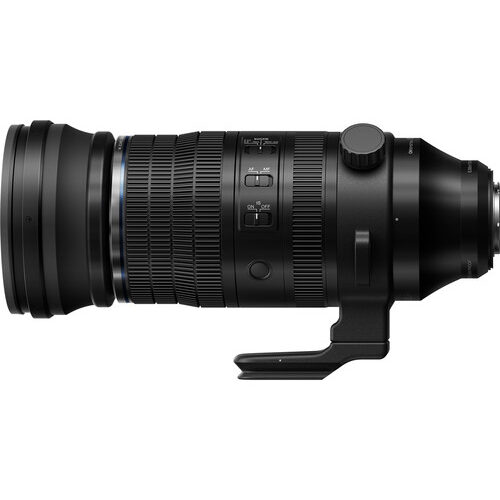
Technical Specifications:
- Micro Four Thirds | f/5-6.3 to f/22
- 300-1200mm (Full-Frame Equivalent)
- Sync Image Stabilization
- Four Super ED Lens Elements
- Weather-Resistant Construction
- Fluorine Coating
OM SYSTEM M.Zuiko Digital ED 150-600mm f/5-6.3 IS Lens
Key Features for Capturing Wildlife in Stunning Detail
- Impressive Focal Length and Zoom Range (150-600mm): Thanks to the crop sensor multiplier, this lens boasts a remarkable 300-1200mm equivalent focal length on Micro Four Thirds cameras. This substantial reach effectively compresses the distance between you and your wildlife subjects. This allows you to capture captivating close-up portraits of birds perched high in trees or wildlife roaming in the distance. The 150-600mm zoom range also offers adaptability for various wildlife encounters.
- High-Resolution Images with Built-In Image Stabilization: Sharpness and clarity are paramount for wildlife photography, especially when cropping into distant subjects (Transition: Importance of Image Quality). The M.Zuiko Digital ED 150-600mm f/5-6.3 IS Lens features high-quality optics and built-in image stabilization (IS). Expect crisp details, even at the telephoto end of the zoom range, and the IS system effectively combats camera shake, ensuring sharp results even in low-light conditions.
- Compact and Lightweight Design for Easy Maneuvering: Super-telephoto lenses often have a bulk penalty. However, the M.Zuiko Digital ED 150-600mm f/5-6.3 IS Lens prioritizes a compact and lightweight design. This makes it significantly easier to carry on long hikes through diverse American landscapes, allowing you to focus on capturing fleeting wildlife moments.
- Fast and Precise Autofocus for Capturing Action: The fast-paced world of wildlife photography demands a lens that can keep up with the action. This OM SYSTEM lens features a fast and precise autofocus system. Expect quick focus lock and tracking to stay locked onto your subjects and capture those unexpected wildlife behaviors.
Pros and Cons: A Feature-Rich Option for Micro Four-Thirds Users
Pros:
- The impressive, effective focal length on Micro Four Thirds cameras for capturing distant wildlife in detail
- High-resolution images with built-in image stabilization for sharp results
- Compact and lightweight design for comfortable portability on hikes
- Fast and precise autofocus system for capturing wildlife action
Cons:
- Variable aperture (f/5-6.3) may limit low-light performance at the telephoto end.
- Not ideal for full-frame mirrorless cameras
Summary: A Powerful Tool for Micro Four-Thirds Enthusiasts
The OM SYSTEM M.Zuiko Digital ED 150-600mm f/5-6.3 IS Lens is a powerful tool for wildlife photographers in the US using Micro Four Thirds cameras. The impressive, effective focal length, high-resolution image quality with built-in stabilization, compact design, and fast autofocus make it ideal for capturing captivating wildlife moments. However, the compatibility of the variable aperture and Micro Four Thirds systems is important to consider before investing.
2) OM SYSTEM M. Zuiko 150-400mm f/4.5 TC 1.25 IS PRO Lens
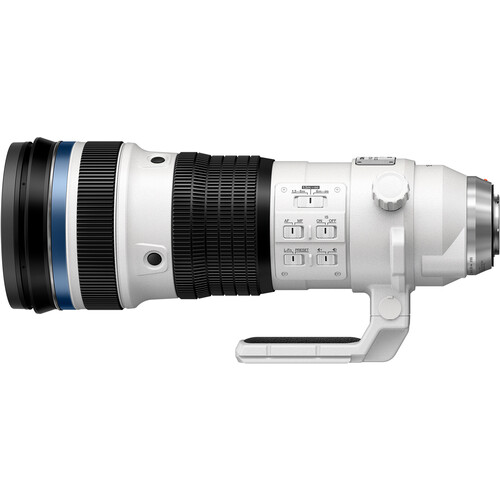
Technical Specifications:
- Type: Zoom Lens
- Mount: Micro Four Thirds
- Focal Length: 150-400mm (300-800mm with built-in teleconverter)
- Maximum Aperture: f/4.5 (f/5.6 with built-in teleconverter engaged)
- Image Stabilization: Yes (Built-in Image Stabilizer)
- Minimum Focusing Distance: 1.3 meters (4.3 feet)
- Filter Diameter: 72mm
- Weather-Sealing: Yes
- Weight: 4.13 lbs. or 1.875 kg
OM SYSTEM M. Zuiko 150-400mm f/4.5 TC 1.25 IS PRO Lens
Key Features:
- Excellent Reach for Micro Four Thirds System: This lens offers a remarkable 150-400mm focal length, which translates to a 300-800mm equivalent focal length on a full-frame camera due to the Micro Four Thirds system’s crop factor. This extended reach allows you to capture compelling close-up portraits of distant wildlife while maintaining a safe distance in their natural habitat.
- Lightweight and Portable: While a telephoto zoom lens, the OM System M.Zuiko Digital ED 150-400mm f/4.5 TC1.25X IS PRO is lighter than many comparable lenses designed for full-frame cameras. This makes it a more manageable option for wildlife photography adventures, especially when hiking long distances or carrying your gear for extended periods.
- Built-in Teleconverter for Extended Reach: The unique feature of this lens is the built-in 1.25x teleconverter. With a simple switch, you can extend the focal length to a staggering 800mm equivalent (full-frame), getting you even closer to the action.
- Fast and Precise Autofocus: The lens utilizes an MSC (Movie Still Compatible) autofocus system that delivers fast, quiet, and precise focusing performance. This is crucial for tracking fast-moving wildlife subjects and ensuring sharp images of those fleeting moments.
- Image Stabilization Advantage: Built-in image stabilization effectively minimizes camera shake, allowing you to capture sharp images at slower shutter speeds that are often necessary in wildlife photography. This is especially helpful when shooting at full zoom or in low-light situations.
Pros and Cons:
Pros:
- Impressive Effective Focal Length: With a built-in 1.25x teleconverter, this lens offers a 375-1000mm equivalent focal length on Micro Four Thirds cameras, thanks to the crop sensor multiplier. This substantial reach brings distant wildlife subjects incredibly close for detailed portraits.
- Excellent Image Quality: This lens boasts high-quality optics and a constant f/4.5 aperture throughout the zoom range, even with the teleconverter engaged. Expect sharp images, good low-light performance, and beautiful bokeh effects.
- Built-In Image Stabilization: The lens features a powerful 5-axis image stabilization (IS) system that effectively combats camera shake, ensuring sharp results even at slower shutter speeds common in wildlife photography.
- Fast and Precise Autofocus: The lens utilizes a high-speed autofocus system for quick focus lock and tracking, perfect for capturing fleeting wildlife moments and action shots.
- Weather-Sealed Construction: The lens is built to withstand challenging weather conditions, making it ideal for outdoor wildlife photography.
- Minimum Focus Distance: This lens boasts an impressive minimum focus distance of just 1.3 meters (4.25 feet) throughout the zoom range, even with the teleconverter. This allows you to capture detailed close-up shots of wildlife.
Cons:
- Larger and Heavier Design: Compared to other Micro Four Thirds telephoto lenses, this lens is larger and heavier. While still more portable than many full-frame super-telephoto lenses, it’s important to consider for long treks.
- Variable Image Quality with Teleconverter: While the image quality remains good, the built-in teleconverter can slightly reduce sharpness and increase the minimum aperture to f/5.6.
- High Cost: This is a premium lens with a premium price tag.
- Micro Four Thirds System Only: This lens is specifically designed for Micro Four Thirds cameras and won’t be compatible with other camera systems.
Summary
The OM System M.Zuiko Digital ED 150-400mm f/4.5 TC1.25X IS PRO lens is an excellent option for wildlife photographers who use Micro Four Thirds cameras. It provides a well-balanced combination of focal length, image quality, portability, and a built-in teleconverter for additional reach, making it an invaluable asset for capturing breathtaking wildlife shots.
The lens is notable for its integrated 1.25x teleconverter. When activated, the effective focal length extends to an impressive 1875mm, ideal for extreme close-ups of wildlife. The base focal range of 150-400mm offers substantial versatility. A consistent f/4.5 aperture across the zoom range ensures solid performance in low-light conditions. The lens’ built-in image stabilization is beneficial for capturing sharp images at lower shutter speeds.
However, the size, weight, cost, and slight reduction in image quality with the teleconverter are important factors to weigh before investing.
3) OM System M.Zuiko Digital ED 100-400mm f/5-6.3 IS Lens:
Wildlife and bird photographers in the US understand the importance of getting close to their subjects without disturbing their natural habitat. Telephoto lenses bridge this gap, but often at the expense of portability. The OM System M.Zuiko Digital ED 100-400mm f/5-6.3 IS Lens seeks to strike a balance, offering a versatile zoom range and good image quality in a relatively compact and lightweight build.
If you’re looking for a lens that promises a user-friendly experience for capturing stunning wildlife imagery, the M.Zuiko Digital ED 100-400 mm f/5-6.3 IS Lens might be perfect. Let’s delve into its key features, weigh the pros and cons, and see if it’s the lens that will elevate your wildlife photography adventures to the next level.
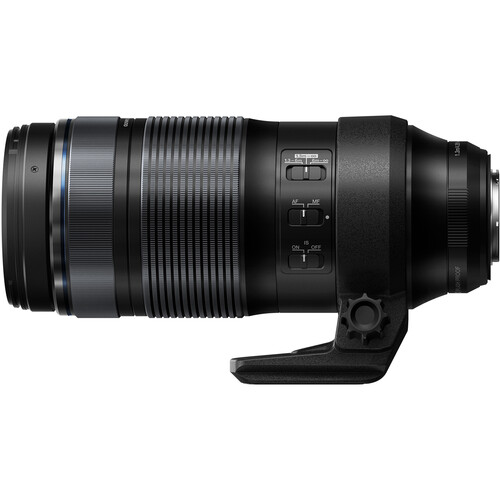
Technical Specifications:
- Type: Zoom Lens
- Mount: Micro Four Thirds
- Focal Length: 100-400mm (200-800mm equivalent focal length on a full-frame camera)
- Maximum Aperture: f/5-6.3
- Image Stabilization: Yes (Built-in Image Stabilizer)
- Minimum Focusing Distance: 0.7 meters (2.3 feet)
- Filter Diameter: 72mm
- Weather-Sealing: Yes
- Weight: 3.04 lbs (1.38 kg)
OM System M.Zuiko Digital ED 100-400mm f/5-6.3 IS Lens
Key Features:
- The OM System M.Zuiko Digital ED 100-400mm f/5-6.3 IS lens is a versatile and portable telephoto zoom lens that is ideal for wildlife photography enthusiasts using Micro Four Thirds cameras.
- It is an affordable option for OM System camera users who are mindful of their budget. Although the variable aperture of f/5-6.3 may limit performance in low-light conditions at the telephoto end, it performs well in adequate lighting. The lens provides a balance of focal length, image quality, portability, and built-in image stabilization, making it an excellent tool for wildlife photography.
- The integrated image stabilization is beneficial for reducing camera shake, ensuring sharper images when shooting handheld. Additionally, this lens is more compact and lighter than the 150-400mm f/4.5 model, offering greater convenience for travel.
Pros and Cons: A Compact Option for Wildlife and Bird Enthusiasts
Pros:
- Versatile zoom range for various birdwatching and wildlife photography situations
- Weather-sealed design for protection against light weather elements
- Built-in image stabilization for sharp results, especially at slower shutter speeds
- Fast and accurate autofocus system to capture fleeting moments
- Compact and lightweight design for comfortable portability on hikes
Cons:
- Variable aperture (f/5-6.3) may limit low-light performance at the telephoto end
- It is not the absolute longest reach for extremely distant wildlife.
Summary: – A Well-Suited Companion for Wildlife Photographers
The OM System M.Zuiko Digital ED 100-400mm f/5-6.3 IS Lens is a well-suited companion for birders and wildlife photographers in the US seeking a versatile and portable zoom lens for Micro Four Thirds cameras (Transition: Summarizing Key Points). The well-rounded zoom range, weather-sealed design, image stabilization, fast autofocus, and compact build make it ideal for capturing captivating wildlife moments on the go. However, the variable aperture and maximum reach are important factors, especially for photographers targeting distant wildlife.
Overall Lens Summary:
The appropriate lens opens up a myriad of opportunities in wildlife photography. It allows you to capture the delicate patterns on a butterfly’s wing or the grandeur of a predator in its habitat, influencing the narratives you can share.
This guide has delved into the some of the lenses for Canon, Nikon, Sony, and OM System cameras, providing you with the essential knowledge to make well-informed choices.
Choosing the right wildlife photography lens depends on your individual needs and shooting style. Consider factors like budget, desired focal length, aperture range, camera system compatibility, and portability.
Experiment with different focal lengths and apertures to discover what works best for you. If you are not sure which lens would be the best fit for you, consider renting a lens and test it out before making an investment in the lens that will work best for you.
FAQs
Q: What is the best camera system for wildlife photography?
A: There is no best camera system. The optimal camera system for wildlife photography depends on your individual needs. Mirrorless cameras are known for their portability and quiet operation, while DSLRs are favored for their long battery life and superior viewfinders. Crop sensor cameras are appreciated for their affordability and the advantage of an increased effective focal length. It’s best to select a system that aligns with your specific priorities.
Q: Which is better for wildlife photography, a prime lens or a zoom lens?
A: Prime lenses provide excellent image quality, larger apertures, and are generally lighter, yet they do not offer zoom capability. Zoom lenses, on the other hand, allow for flexible framing but may have smaller apertures. Your budget and preferred photography style should guide your choice.
Q: How important is image stabilization for wildlife photography?
A: Image stabilization is very important for wildlife photography, especially when using telephoto lenses or shooting in low-light conditions. It helps counteract camera shake and ensures sharper images at slower shutter speeds.
Q: Can I use a full-frame lens on a crop sensor camera?
A. Yes, you can physically mount a full-frame lens on a crop sensor camera body. However, the camera will only use the center portion of the lens’s image circle, effectively cropping the field of view. This can be advantageous for wildlife photography because it provides an increased effective focal length, bringing you closer to your subject. But it’s important to be aware that you’ll lose some image resolution on the edges.
Beyond the Lens
While the lens plays a starring role, other factors contribute to successful wildlife photography. Consider these additional elements:
Teleconverters
For even more reach, teleconverters can be paired with compatible zoom lenses to effectively extend their focal length. However, they might introduce some image quality loss.
Image Stabilization: A Steady Hand in the Wild
When working with longer focal lengths – especially 300mm and beyond – image stabilization (IS) becomes a critical feature in your lens. At these extended ranges, even the slightest movement can cause noticeable blur, especially in low light or when shooting handheld. That’s where IS steps in to minimize camera shake, allowing you to capture sharp, clear images even at slower shutter speeds.
Modern lenses with built-in stabilization technology help ensure your shots stay tack-sharp when conditions aren’t ideal. Such as shooting from a windy ridge or tracking a fast-moving subject without a tripod. Some systems even offer multiple stabilization modes designed for panning, static shots, or erratic subject movement.
While image stabilization is a powerful ally, it’s not the only tool in your arsenal. For those times when absolute stability is key—like long exposures or heavy super-telephoto setups – a solid tripod makes all the difference.
Don’t miss our in-depth guide on the best wildlife photography tripods, where we share the support systems we trust in the field. Pairing IS with a quality tripod? Now that’s a recipe for tack-sharp success.
Weather Sealing: Built for the Wild
As you venture into the great outdoors, it’s important to remember that wildlife photography rarely happens under perfect conditions. From misty mornings to dusty trails, the environment can change quickly—and not always in your favor.
That’s where weather-sealed lenses come in. Designed to withstand the elements, these lenses provide an added layer of protection against dust, moisture, and even the occasional splash of water. Whether you’re photographing elk in the rain or tracking birds near the shoreline, weather sealing helps ensure your gear continues to perform reliably.
But how can you tell if a lens is weather-sealed?
How to Know if a Lens Has Weather Sealing
To make an informed choice, consider the following tips when researching a lens:
Read Field Reviews
Finally, we always recommend consulting field tests and reviews from other trusted photography sites or YouTube reviewers who put gear through real-world use. They often share how lenses perform in rain, dust, or snow.
Check the Manufacturer’s Specs
Start by visiting the official website of the lens manufacturer. Weather sealing sometimes described as “dust – and moisture-resistant” will be listed under the product features or specifications.
Look for Series Labels
Certain lens lines are known for robust build quality and weather protection:
- Canon: Look for the L-series (identified by a red ring around the barrel). These often feature weather sealing, especially when paired with a weather-sealed body.
- Nikon: The S-line Z-mount and many pro-level F-mount lenses are weather-sealed.
- Sony: G Master (GM) and many G-series lenses typically offer dust and moisture resistance.
- OM System / Olympus: Their PRO lenses are well-known for rugged weather sealing.
- Sigma & Tamron: Many newer high-end lenses from both brands feature weather-resistant construction – check the product details to be sure.
Look for Physical Clues
A rubber gasket around the lens mount is a telltale sign of some level of sealing. While not conclusive, it’s a good indicator the lens has been built with environmental resistance in mind.
In addition to choosing a weather-sealed lens, there are several ways to protect your lens from the elements, bumps, and everyday wear and tear especially when you’re out in the wild. Such as:
- Use a UV or Clear Protective Filter
- Lens Hood: Not Just for Sun Glare
- Rain Covers and Weather Wraps
- Neoprene Lens Covers
- Use a Padded Lens Case or Insert
- Clean and Maintain Regularly
- Watch for Condensation
Wrap-Up: Layer Your Protection
Much like you’d dress in layers to brave the elements, protecting your lens is all about layered defense:
- A lens hood and UV filter for everyday use.
- Neoprene covers and padded cases for travel.
- Rain covers when the skies turn dark.
Incorporate weather sealing (if available), and your lens will be as adventure as you are. Additional for safeguarding your camera and lenses and be discussed an upcoming blog.
Two Camera Bodies
Professional and serious wildlife photographers typically carry two camera bodies; each fitted with a distinct lens. This strategy enables them to swiftly adapt to different scenarios without the need to change lenses. For example, one body may be paired with a prime lens for superior image quality of nearby perched birds, while the second body may be equipped with a zoom lens to capture the dynamic movements of distant animals.
Group Dynamics
When photographing with a group using zoom lenses, they may capture a broad range of wildlife without moving. However, using a prime lens often requires more movement to achieve the ideal shot, which could disturb the wildlife or cause you to miss transient moments. This is why having two camera bodies – one with a prime lens and another with a zoom lens—can be extremely advantageous.
Experiment Before You Invest
When it comes to wildlife photography, choosing the right lens depends on your personal preferences and photography style. There are several factors to consider such as budget, preferred focal length, aperture range, camera system compatibility, and ease of transport.
If you’re not sure which lens to choose, there’s good news! Many camera shops and rental services offer the option to rent lenses before making a purchase. This is an excellent way to experiment with different focal lengths and apertures to find the perfect fit for your photography needs and budget. Renting allows you to “test drive” the lens before investing in it, ensuring that you get the right lenses for your wildlife photography adventures. Also, some of your wildlife photographer friends may let you try out their lenses before you invest in expensive glass.
In our next blog, we’ll delve deeper into another essential piece of equipment – tripods.




